Price Points by Omnia Retail

14.04.2025
Marketplace Pricing Secrets: Should You Use Different Prices on Amazon vs eBay?
Pricing on online marketplaces plays a vital role in e-commerce success. Online marketplaces now make up 62% of all online purchases. Retailers who sell on multiple platforms earn 190% more revenue than those selling on...
Pricing on online marketplaces plays a vital role in e-commerce success. Online marketplaces now make up 62% of all online purchases. Retailers who sell on multiple platforms earn 190% more revenue than those selling on a single channel. These numbers show the massive potential of a smart marketplace strategy. Setting the right prices across different marketplaces remains challenging. Amazon's marketplace illustrates this perfectly - 63% of its shoppers check prices before buying, while close to 2 million sellers compete for the Buy Box. A powerful marketplace pricing strategy matters more than ever. Different pricing on platforms like Amazon and eBay might help maximize your revenue. This piece will guide you in building an analytical pricing framework, highlight key differences among various marketplaces, and provide tips for developing differentiated marketplace strategies. These practical approaches will help you understand why its important to optimize prices and maintain profitability on each platform. Building Your Marketplace Pricing Strategy Framework A marketplace pricing strategy requires a clear framework that aligns with each platform's unique ecosystem. Selling across platforms demands a more strategic approach than traditional retail. You need to consider varying customer expectations and operational costs. Brands, retailers, and consumers all converge on these platforms, each with their own motivations and benefits. Brands and retailers leverage marketplaces to enhance visibility, boost profitability, and assess price competitiveness. Meanwhile, consumers are drawn to marketplaces for the convenience of comparing prices across multiple vendors without the hassle of navigating different websites. How do marketplaces shape online pricing? Marketplaces significantly influence pricing dynamics. The low entry barriers allow more competitors to join easily, reducing the need for extensive SEO and SEA efforts. This environment fosters dynamic pricing, where prices fluctuate based on various factors. Consumers benefit from increased transparency, not only in pricing but also in delivery and service options. Additionally, marketplaces introduce Buy Box dynamics, making pricing less static and more competitive. What do we know about the pricing differences in marketplaces? In an in-house research study, we analyzed data from the beauty, sports, and fashion industries across different marketplaces in Germany between January and December 2024, focusing only on non-promotional weeks. This comprehensive analysis allowed us to identify key trends and pricing behaviors unique to each marketplace. By examining these patterns, we can better understand how various factors, such as competition and consumer preferences, shape pricing strategies across the board. Marketplace Pricing Differences Marketplace pricing is not one-size-fits-all Different levels of competition and fee structures influence pricing per platform. Some marketplaces encourage low pricing, while others allow premium positioning. Most vendors adjust prices per platform 61.1% of vendors use a differentiated pricing strategy tailored to marketplace dynamics. No single marketplace consistently offers the lowest price, making pricing decisions complex. Price trends reveal strategic opportunities Amazon maintains stable pricing. eBay shows higher price volatility. Kaufland positions itself with consistently higher prices. Pricing strategies vary significantly per marketplace Some platforms have more competition encouraging low pricing, while other maintain different fees leading to higher pricing. Amazon tends to have lower prices than eBay, indicating a more competitive landscape. In comparison to Kaufland we would see lower pricing, indicting a difference in fees. Understanding price trends across marketplaces helps identify competitive differences and strategic opportunities. While Amazon maintains stable pricing, eBay shows volatility, and Kaufland positions itself with consistently higher prices. Amazon.de: Stable Pricing - Likely automated repricing, fewer fluctuations eBay.de: More volatile, declining prices - Price-sensitive sellers, heavy competition Kaufland.de: highest and most stable prices - Less discounting, possibly premium positioning Understanding your competition in different marketplace You need to know your competition in marketplaces to position your products well. Each platform draws different customer groups with unique price sensitivities. Amazon shoppers compare prices 63% of the time before buying, which makes competitive pricing vital. Software like Omnia help you track competitors' pricing patterns and learn about market trends to make smart decisions. Creating clear pricing strategies for each marketplace Your marketplace pricing framework needs specific goals translated into pricing strategies. These goals should line up with your bigger business plans, whether you want to maximize quick profits through price skimming or gain long-term market share through penetration pricing. Your pricing goals might change between platforms. Amazon's fierce Buy Box competition might make competitive pricing your top priority. eBay lets you retain control over customer relationships and branding, so you might focus on higher margins or customer loyalty. Smart and dynamic pricing strategies will keep your business profitable long-term. They help maintain your market position and build customer loyalty. Data-Driven Decision Making for Cross-Platform Pricing Companies that use data based analysis to set their marketplace prices make better decisions. Research shows data-driven organizations are 19 times more likely to remain profitable. Highquality data, such as provided by Omnia, plays a crucial role to optimize your cross-platform pricing strategy. Analyzing current marketplace data in Omnia Omnia’s offering includes price monitoring across multiple domains, featuring a user-friendly interface that encourages collaboration on various market strategies, including international ones. An all-in-one solution is essential for optimizing and implementing automated pricing strategies across platforms in the long term. Here are some questions that Omnia can help you answer: Which marketplace has the highest number of listings for different categories? Are your main competitors more active in one domain than others? Which marketplace has the most offers below your selling price? Which marketplace shows the largest average price difference compared to your selling price? Which marketplace has the least price variation? How can Omnia help? Wide array of marketplaces data source to choose from in different countries Options to choose the different data points from directly scraped marketplaces. Eg: bol sold by bol or cheapest on bol. Competitor selections in the pricing tree based on the different marketplaces Blacklist and whitelist different data points from marketplaces from price calculations Timing your price changes for maximum effect - With Omnia, get pricing data whenever you wish and automatically update your prices. Unlock smarter marketplace pricing & schedule a pricing insights session. Schedule demo here Measuring Success and Optimizing Your Pricing Strategy Successful marketplace pricing needs regular evaluation and updates. Companies that rely on analytics are 6% more profitable than their competitors. Measurement plays a vital role in your cross-platform pricing strategy. Key performance indicators for cross-platform pricing The right metrics help you make better pricing decisions across marketplaces. These are the vital KPIs to track: You should watch how price changes affect each metric. Regular monitoring helps you spot trends and adjust your marketplace pricing strategy as needed. Understanding how market conditions and the prices of your competitors impact sales is crucial. With Omnia’s insight, you will be able to better assess the influence of factors like competitor pricing on your product’s performance. Long-term vs. short-term pricing considerations Smart pricing balances quick wins with sustainable growth. Short-term pricing aims for fast gains through promotions or temporary discounts. Long-term strategies focus on customer loyalty and steady revenue. Many new sellers focus only on revenue, but this approach can mislead. Pricing Expert Prof. Hermann Simon, puts it well: “Profit orientation is the only meaningful goal because it is the only one that observes both the market side and the cost side”. The priority should be profit margins that keep operations running smoothly. Setting competitive prices while maintaining profits is vital for lasting success. Your pricing strategy must evolve with market conditions, seasons, and other factors. Conclusion Smart pricing across marketplaces gives sellers the most important advantages. Market data reveals that sellers who match their prices to each platform's unique features perform better than those who use the same prices everywhere. Sellers need to find the right balance between being competitive and making a profit. Amazon's fierce Buy Box competition demands aggressive pricing, but it often shows more stable pricing patterns. This stability is likely due to the widespread use of automated repricing tools that reduce fluctuations. In contrast, eBay.de experiences greater volatility, with prices often dropping due to intense competition among price-sensitive sellers. This marketplace allows for more flexible approaches. Meanwhile, Kaufland.de maintains the highest and most stable prices, indicating a premium positioning strategy that could benefit brands looking to differentiate themselves in the marketplace. Each platform's environment needs customized pricing to ensure profitable growth. Making use of highquality data is the life-blood of effective cross-platform pricing. Quick responses to market changes come from analyzing key metrics, watching competitors, and using dynamic pricing software. Platform pricing may look complex. A systematic approach to these strategies will help build a lasting competitive edge. Your pricing strategy needs constant fine-tuning. To stay ahead, it's essential to regularly assess market trends and competitor actions. With our Omnia team by your side, you can leverage advanced analytics and insights to refine your approach, ensuring that your pricing remains competitive and aligned with your overall business objectives. Learn more about our revolutionary and intuitive approach to Dynamic Pricing here. FAQ Is it beneficial to use different pricing strategies on Amazon and eBay? Yes, using different pricing strategies on Amazon and eBay can be advantageous. Each platform has unique characteristics and customer behaviors, so tailoring your prices to each marketplace can help maximize revenue potential and maintain competitiveness. Read More Is it beneficial to use different pricing strategies on Amazon and eBay? How often should I adjust my prices on online marketplaces? The frequency of price adjustments depends on your goals, competitiveness in the market, and marketplace-specific characteristics. With Omnia, you get your competitor’s pricing data whenever you wish and automatically update your prices. Read More How often should I adjust my prices on online marketplaces? How can I track competitors’ pricing on marketplaces like Amazon, Bol.com, or Zalando? You can track competitors' prices on all popular marketplaces like Amazon, Bol.com or Zalando, but also on niche marketplaces or direct stores using pricing software like Omnia. The software provides an overview of who else is offering the same products, on which marketplaces, and at what price - including market averages and how your prices compare, either by item price or total price including delivery. You can also dive into detailed competitor analysis for each marketplace, with the flexibility to pull pricing data at any time of day. Read More How can I track competitors’ pricing on marketplaces like Amazon, Bol.com, or Zalando? How accurate and real-time is marketplace pricing data? Marketplace pricing data can be highly accurate and real-time, especially when using Omnia Retail. Unlike other software that limits users to fixed schedules, Omnia allows pricing data to be refreshed at any chosen time of the day, offering unmatched flexibility and up-to-date insights. Read More How accurate and real-time is marketplace pricing data? How do I get insights into Buy Box dynamics? To gain insights into Buy Box dynamics, sellers should focus on optimizing product listings with relevant keywords, high-quality visuals, and detailed descriptions, while maintaining competitive pricing and excellent customer service. Marketplace-specific factors, such as Amazon's emphasis on fulfillment and eBay's focus on keyword relevance, also play crucial roles in determining Buy Box winners. Read More How do I get insights into Buy Box dynamics? Read more about interesting pricing strategies here: What is Dynamic Pricing?: The ultimate guide to dynamic pricing. What are the best pricing strategies?: Read about 17 pricing strategies for you as a retailer or brand. What is Price Monitoring?: Check out everything you need to know about price comparison and price monitoring. What is Value Based Pricing?: A full overview of how price and consumer perception work together. What is Charm Pricing?: A short introduction to a fun pricing method. What is Penetration Pricing?: A guide on how to get noticed when first entering a new market. What is Bundle Pricing?: Learn more about the benefits of a bundle pricing strategy. What is Cost Plus Pricing?: In this article, we’ll cover cost-plus pricing and show you when it makes sense to use this strategy. What is Price Skimming?: Learn how price skimming can help you facilitate a higher return on early investments. What is Map Pricing?: Find out why MAP pricing is so important to many retailers.
Marketplace Pricing Secrets: Should You Use Different Prices on Amazon vs eBay?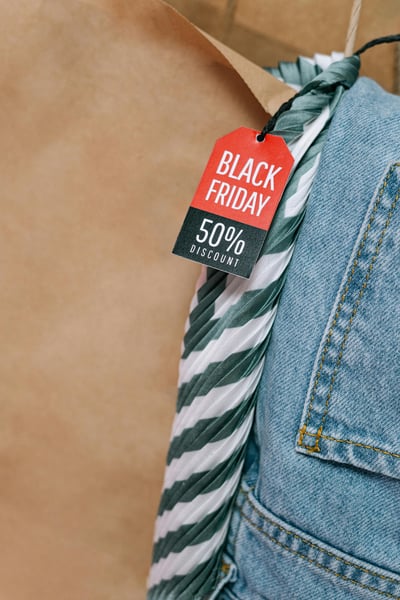
15.10.2024
Understanding the impact of early preparation for Black Friday
Preparing early for Black Friday is essential for retailers looking to maximise sales and stay competitive in a dynamic market. By planning ahead, retailers can strategically adjust pricing, manage inventory and...
Preparing early for Black Friday is essential for retailers looking to maximise sales and stay competitive in a dynamic market. By planning ahead, retailers can strategically adjust pricing, manage inventory and fine-tune marketing campaigns to attract more customers. This proactive approach enables the identification of key product and market trends, ensuring that promotions are both timely and effective. In addition, early preparation helps to mitigate potential logistical challenges, such as stock shortages or delivery delays, which can negatively impact customer satisfaction. Finally, preparation enables retailers to navigate the complexities of dynamic pricing and price monitoring, ensuring that they can capitalise on increased consumer activity during this peak shopping period. In our recent research, we looked at data from the sports fashion and electronics industries in the Dutch and German markets from 2018 to 2023. The analysis focused on products with price deviations and consistent data streams, providing insights into dynamic pricing, price monitoring and pricing strategies during the Black Friday period. Key findings 1) Early start of Black Friday promotions Our research shows that Black Friday promotions start 10 days before the actual event. This early start continues through the weekend, creating a highly competitive environment. Retailers start lowering prices as early as mid-October, with the biggest discounts occurring on Black Friday and continuing through the weekend. Chart 1: Timeline before, during and after Black Friday. Retailers begin lowering prices as early as mid-October, with the most significant discounts occurring on Black Friday and continuing through the weekend. 2) Post-Black Friday price trends Prices tend to return to pre-Black Friday levels, but gradually decline towards Christmas and beyond. This trend indicates a continuous price decline, influenced by the dynamic pricing strategies employed during the festive season. 3) Impact of the Omnibus ruling The European Union's omnibus ruling in 2022 significantly changed promotional strategies. By 2023, the impact of the ruling was evident as retailers adjusted their pricing tactics to comply with the new regulations. This change disrupted the typical product lifecycle, particularly during the Black Friday period. Talk to one of our consultants about dynamic pricing. Schedule a demo Prepare with 3 key actions to gain a competitive advantage on Black Friday To maximise your competitive advantage this Black Friday, focus on three essential actions before you start your strategies: Identify key players, analyse key products and evaluate key areas. By mastering these three areas, you can create a robust strategy that leverages your competitive advantage and drives success during the Black Friday period. 1) Identifying Key Players One of the first steps is to identify the key players in your market. This process is critical to understanding competitive dynamics and ensuring that your pricing strategies are effective. Questions to ask: Which retailers are price competitive? How often do the key players change their prices? How do the promotional strategies of key players differ from ours? How often should we review and update our blacklist of unreliable offers? In addition to the data available and the overview provided by our dashboards, Omnia's price monitoring software offers two indicators to measure the strength of the key players and quickly identify them. The Price Ratio Variance benchmark allows you to measure the consistency of offers against your current selling price. You can use this metric to assess which key players you should - or should not - focus on in your Black Friday pricing rules. A higher variance indicates greater inconsistency and less uniformity in offers. To ensure the accuracy of our analysis , a recently released new feature that blacklists offers identified as outliers or those with unreliable stock information helps to maintain a more normalised view of the market, especially during the Black Friday period. 2) Analysing Key Products The next step in your preparation is to analyse key products. This is essential to identify significant price variation and understand how competitors are pricing similar items. Identify products with significant price variation per area by analysing the Price Stability Score: Assess how closely your competitors' prices match your own. A score of 100 indicates identical pricing, while a score of 0 means there are significant price differences. By monitoring these scores on a daily basis, you can see which products are moving within their promotions. Top 10 Performers (Slice 1): The Price Stability Score helps you to find out at a glance to what extent your prices for products overlap with those of your relevant competitors. When preparing for Black Friday, it’s important to focus on products with significant price deviations. By filtering dashboards based on the lowest price stability scores, you can identify the most volatile items and plan your promotions accordingly. 3) Evaluating Key Domains When preparing for Black Friday, it’s important to focus on products with significant price deviations. By filtering dashboards based on the lowest price stability scores, you can identify the most volatile items and plan your promotions accordingly. Finally, evaluating key domains is crucial for determining where to focus your marketing spend and promotional efforts. This involves analysing the lowest unit prices across different markets and making informed decisions about where to allocate resources. Within the Omnia software, you can analyse relevant marketplaces and domains by examining the lowest unit price. By identifying the cheapest unit price, we can determine the most effective domain for promotions. If the goal is to offer the product for €20, it makes sense to focus on Kieskeurig, where the price aligns with this target. Conversely, it would be less effective to promote on Tweakers, where the price is significantly lower at €14.79. By combining various dashboards in your price monitoring software, you can gain a comprehensive understanding of market dynamics and better prepare for Black Friday. This holistic approach allows you to navigate the complexities of dynamic pricing and develop effective pricing strategies that enhance your competitive edge. Top 4 strategy ideas to make a success of Black Friday Once the market is understood and you know how you are positioned in the market, the next step is to see what kind of strategies you can implement in your Pricing Strategy Tree in Omnia during Black Friday. 1) Follow the Price Movement in the Market As Black Friday approaches, retailers have begun lowering their prices 10 days in advance. This early discounting is part of a dynamic promotion strategy across different assortments. To effectively track market movements ahead of Black Friday, it's important to include promotional products during the Black Friday period itself. You can still follow market prices to be competitive while ensuring that the cheapest price will be the promotional price during the promotional period. This allows for a comprehensive understanding of price trends and competitive positioning. Several conditions can be used in combination: Stock age: Adjust prices based on how long products have been in stock. Selected competitors: Monitor and compare prices with only selected competitors. Sales Through Rate: Consider the rate at which products are sold to adjust prices accordingly. 2) Promotional price for X units only We often see that in the lead up to Black Friday, companies tend to send out brochures, newsletters and promote some products with special prices on their various marketing channels. These are usually products that are popular in the market, some bestsellers or high runners that have good demand and will attract people to come to your websites when you have good deals on them and hopefully also drive sales of the other complementary products that are on the websites. Sometimes you also have a limit to this especially good price and hence, only want this price to be for X number of units sold. This can be translated into the following pricing rule: Special price only for X units sold, after which it will follow the market prices with assigned safety rules. Pricing Strategy Tree: On the 29th of November (Black Friday 2024), only the first 100 units of the products with assigned special/ promotional prices, will have the promotional price and once it reaches 100, the next price will follow the lowest price of the selected competitors with a minimum boundary of the promotional price/ special price + 5% and a maximum boundary of the MSRP/RRP 3) Avoid Price War Rather than always following the cheapest, identify the situations in which you want to follow the market down. During promotional periods such as Black Friday, it may be strategic to adjust prices temporarily to remain competitive. For example, you may only lower your prices and follow the market down (with respect to a minimum price boundary) under certain conditions, such as when stock reaches a certain age or when there are a defined number of competitors in the market. Pricing Strategy Tree: From 19th of November, for the Electronics products, depending on their stock age, the price is following the cheapest price amongst the selected competitors with minimum safety price and maximum price ONLY IF there are at least 2 of these selected competitors with prices lower than your current selling price. 4) Strategic Price Adjustments post Black Friday The price decrease and increase before and after black friday have bigger scale than the other normal period. Follow the market as retailers start increasing their prices post Black Friday but at a steady rate to avoid too big of price fluctuations. By adjusting prices with a stabilised increase, retailers can ensure a smoother transition to post-Black Friday pricing, maintaining customer confidence and business stability. Example of how this can be translated into a pricing rule: From 30th November until the end of Cyber Monday, follow the average price in the market among selected competitors, but in case of sharp price increases, limit the increase to max. 5% with a maximum of MSRP/RRP and a minimum of either promotional price or minimum margin. Conclusion: Optimise your Black Friday strategy and save time with Omnia's pricing software At Omnia, we aim to empower you with the ability to gather and analyse these insights independently. Our new tool allows you to slice and dice the data using different benchmarks, giving you a comprehensive view of how dynamic pricing and price monitoring can be applied in your industry. Benchmark against competitors: Compare your pricing strategies with competitors to identify areas for improvement. Analyse seasonal trends: Understand how seasonal events such as Black Friday impact your pricing and adjust your strategies accordingly. Regulatory compliance: Ensure that your pricing strategies comply with regulations such as the Omnibus Directive. With these insights and more, you can navigate the complexities of dynamic pricing and develop effective pricing strategies that increase your competitive advantage. Read more about interesting pricing strategies here: What is Dynamic Pricing?: The ultimate guide to dynamic pricing. What our the best pricing strategies?: Read about 17 pricing strategies for you as a retailer or brand. What is Price Monitoring?: Check out everything you need to know about price comparison and price monitoring. What is Value Based Pricing?: A full overview of how price and consumer perception work together. What is Charm Pricing?: A short introduction to a fun pricing method. What is Penetration Pricing?: A guide on how to get noticed when first entering a new market. What is Bundle Pricing?: Learn more about the benefits of a bundle pricing strategy. What is Cost Plus Pricing?: In this article, we’ll cover cost-plus pricing and show you when it makes sense to use this strategy. What is Price Skimming?: Learn how price skimming can help you facilitate a higher return on early investments. What is Map Pricing?: Find out why MAP pricing is so important to many retailers.
Understanding the impact of early preparation for Black Friday
13.08.2024
The Ultimate Guide to Dynamic Pricing
What is Dynamic Pricing? Dynamic pricing is when a company or store continuously adjusts its prices throughout the day. The goal of these price changes is two fold: on one hand, companies want to optimize for margins,...
What is Dynamic Pricing? Dynamic pricing is when a company or store continuously adjusts its prices throughout the day. The goal of these price changes is two fold: on one hand, companies want to optimize for margins, and on the other they want to increase their chances of sales. Dynamic pricing is a pricing strategy that applies variable prices instead of fixed prices. Instead of deciding on a set price for a season, retailers can update their prices multiple times per day to capitalize on the ever-changing market. Dynamic pricing often gets confused with personalized pricing. But these two different types of pricing are extremely different from one another. To put it simply, dynamic pricing looks at your products and and their relative value in relation to the rest of the market. Dynamic Pricing vs Personalized Pricing Personalized pricing, on the other hand, looks at individual consumer behaviors and gauges (and changes) a product’s value based on past shopping experience. Personalized pricing is controversial because it uses individual data and shopping experiences information that many consumers consider private and personal. It’s also somewhat risky in an age where consumers can interact with and talk to each other like never before. If Consumer A finds out they paid more for the exact same product than their best friend, their trust in a company will erode. Dynamic pricing, on the other hand, allows you to capture extra sales and take advantage of a changing market without invading consumer privacy or trust. Why is Dynamic Pricing important in e-commerce? Dynamic pricing and e-commerce co-evolved together. As the internet became more sophisticated and online shopping grew, so has the need for dynamic pricing. Consumer electronics was one of the forerunners in the retail landscape in terms of the trend towards online. As a category of elastic products that are sensitive to price changes, it makes sense. Retailers need dynamic pricing to stay on top of the market and continue to offer competitive prices. But as consumer spending rises in this category (and with it the online market share), two developments that affect dynamic pricing have emerged: Increased price transparency: As more people shop for consumer electronics online, the amount of comparison shopping also increased. Consumers are now far more likely to evaluate a retailer’s prices against the company’s competition. This shines a spotlight on your product price and makes it the most important part of each sale. Since consumer electronics are typically highly elastic, a 5%-10% difference between your price and your competitors could be the deciding factor for a consumer. More frequent price changes: Because of this increased demand for price transparency and matching, the number of prices changes every day has increased dramatically since the dawn of e-commerce. Traditionally, the supplier or the manufacturer would determine the price of a product with a consumer advised price (CAP). However, this CAP quickly became irrelevant with the growth of comparison shopping online. Today, prices are determined by the retailer instead of a supplier, and are based on a variety of variables, including general market trends, competition prices, and stock levels. A complete guide to Dynamic Pricing Download free whitepaper A variety of other categories, such as Toys and Games, for example, follow the same pattern: when online spending rises, so does the demand for price transparency. This, in turn, leads to an increased frequency of price changes and the use of dynamic prices. This trend often also attracts new players on the market without physical stores, which makes it difficult for traditional retailers. Although the traditional retailers have the first mover advantage, they are generally less flexible in adapting their (pricing) strategy. However, the retailers that do capitalize on their omnichannel advantage can move ahead of the pack. What are the benefits of Dynamic Pricing? Dynamic pricing is no longer just a strategy for airlines, hotels or ride-sharing apps. For large retailers and D2C (Direct-to-Consumer) brands, embracing dynamic pricing can unlock significant growth opportunities, enhance profitability, and strengthen customer relationships. Here’s why dynamic pricing should be a cornerstone of your pricing strategy: 1. Maximizing Revenue Potential Dynamic pricing allows retailers and D2C brands to adapt prices in real-time based on demand, inventory levels, and market trends. By pricing high-demand products competitively or increasing margins on less price-sensitive items, you can optimize revenue streams without alienating customers. 2. Staying Competitive in a Fast-Moving Market Retail is a highly competitive space, where prices are compared at the click of a button. Dynamic pricing ensures that your brand remains competitive without resorting to blanket discounts, enabling you to respond to competitor price changes swiftly and strategically.Monitoring your competitors' prices enables you to quickly adapt your pricing strategies. 3. Improved Inventory Management For retailers and D2C brands, holding unsold inventory can lead to wasted resources and lost profits. Dynamic pricing can be used to strategically discount slow-moving products while maximizing profitability on in-demand items, keeping inventory turnover healthy. 4. Data-Driven Decision Making Dynamic pricing software harnesses advanced analytics to provide actionable insights into customer behavior, market conditions, and pricing performance. These insights enable brands to make smarter, data-backed pricing decisions, resulting in higher margins and better customer experiences. Dynamic Pricing software By leveraging pricing software, you can simplify the complexities of implementing dynamic pricing, integrate seamlessly into your operations, and realize measurable business outcomes. Most retailers practice a most basic form of dynamic pricing by discounting items at the end of a season or using a clearance sale to get rid of extra stock. However, dynamic pricing can go much further than a discount at the end of a season. When you use a dynamic pricing software, you can wield the power of data to capture more sales and take control of your assortment. Today, almost all major retailers will use some sort of dynamic pricing software. Dynamic pricing software has obvious benefits online: you can follow the competition, adjust prices instantly, and easily capture quantitative metrics about your store to improve your performance. Dynamic Pricing is also useful offline. Through the use of electronic shelf labels (ESLs), you can easily apply dynamic pricing practices to your physical store. This helps you keep your prices up-to-date with what you present online, and makes pricing management easier. Dynamic Pricing software can help you stay in control of your pricing strategies. What are Dynamic Pricing strategy examples? Traditionally, there are three basic ways retailers set their prices: the cost-plus method, the competitor-based method, and the value based method. The cost-plus method is the most simple out of all three. All you need to do is take the cost of your product and add the desired margin on top of that cost. The main advantage of cost-plus pricing is that it’s easy to understand and implement. However, its main disadvantage is that it only considers internal factors, ignoring external market conditions. To determine the margin or 'markup' percentage, use this simple formula: subtract the product's cost from its selling price, then divide that difference by the cost. Finally, multiply the result by 100 to get the markup percentage. The competitor-based method follows your competition. If your competitor changes their price, you’ll change your price as a result, whether that’s to be lower or higher than your competition. The main advantage of this pricing approach is that it considers external factors like competitor pricing. However, its downside is that it assumes competitors have accurately set their prices. The value-based pricing method follows the price elasticity of a product. Different consumers value items differently, so everyone has a certain threshold that they are willing to pay for a product. A value-based pricing method capitalizes on the public’s perception of the value of a product and charge accordingly. The main advantage of this pricing method is that it integrates both external and internal data, providing a balanced approach. However, its main drawback is its complexity, making it the most difficult pricing method to implement. Dynamic pricing software allows you to combine different pricing methods at the same time. Some softwares also allow you to incorporate other useful information, such as your stock levels, popularity score, and even the weather forecast. How Philips implemented Dynamic Pricing Read case study How to implement Dynamic Pricing? Implementing dynamic pricing is a journey, one that has a lot of twists and turns. And it does create a big change in your organization. That’s why you should view the adoption of dynamic pricing as an opportunity to improve your overall pricing strategy and internal systems, as well as your overall margin. After hundreds of implementation projects, we’ve come up with a five-step process to successfully implement dynamic pricing: Define your commercial objective: Your commercial objective is like your company’s compass: it’ll help you navigate any institutional changes and keep you heading in the right direction. The commercial objective applies to more than just pricing and marketing, but it’s the first step for a successful dynamic pricing strategy. Learn more about how to define your commercial objective here. Build a pricing strategy: Your pricing strategy takes your commercial objective, then translates it into strategy that your team will use to sell products. An example? Say your overall commercial objective is to be known as the cheapest retailer on the market. Your pricing strategy would then be to make sure every product in your store is cheaper than the competition’s offering. To develop an effective pricing strategy, follow a three-step approach. Learn how to build a pricing strategy here: Assess Your Place in the Market Start by evaluating your current pricing model—this is known as the "As-Is Situation." Gather stakeholders to review your existing approach and answer key questions: What is your current pricing model, and what are its strengths and weaknesses? Are you a market leader or a challenger? Is your focus on maximizing sales volume or overall profitability? This reflection helps you understand where you stand before making any changes. Build Your Pricing Strategy Framework Next, engage stakeholders in solution sessions to establish a shared understanding of the As-Is analysis. Many assume this step is unnecessary, but it's crucial to ensure everyone is on the same page about existing pricing strategies. Use these sessions to review findings and create a draft framework. This involves leveraging expertise from sales, segment managers, and pricing specialists to craft a strategy that aligns with your business goals and customer needs. Set Business Rules for the Future With a clear framework in place, the next step is defining the "To-Be Situation"—how you want your pricing to function going forward. Establish the levers and rules that will guide your pricing and calibrate them based on your analysis. After aligning internally, begin testing and iterating these rules using tools like Omnia to see what adjustments yield the best results. Choose your pricing method(s): Your pricing strategy tells you what you want to do. Your methods are how you’ll achieve those pricing goals. Your pricing methods are more specific than your pricing strategy. Establish pricing rules: Pricing rules tell your dynamic pricing software what to do. You should set a rule for every product that the software needs to track and change. Test and monitor: The final step for getting started with dynamic pricing is to test and monitor your software’s changes. Learn more about testing the effectiveness of your online pricing. Read more about interesting pricing strategies here: What our the best pricing strategies?: Read about 17 pricing strategies for you as a retailer or brand. What is Price Monitoring?: Check out everything you need to know about price comparison and price monitoring. What is Value Based Pricing?: A full overview of how price and consumer perception work together. What is Charm Pricing?: A short introduction to a fun pricing method. What is Penetration Pricing?: A guide on how to get noticed when first entering a new market. What is Bundle Pricing?: Learn more about the benefits of a bundle pricing strategy. What is Cost Plus Pricing?: In this article, we’ll cover cost-plus pricing and show you when it makes sense to use this strategy. What is Price Skimming?: Learn how price skimming can help you facilitate a higher return on early investments. What is Map Pricing?: Find out why MAP pricing is so important to many retailers.
The Ultimate Guide to Dynamic Pricing
26.09.2023
Shopping Experience - What does Shopping Experience mean?
What does shopping experience mean? The term shopping experience covers all aspects of how a customer experiences its interactions with a vendor, at every touchpoint from the first contact through the transaction and...
What does shopping experience mean? The term shopping experience covers all aspects of how a customer experiences its interactions with a vendor, at every touchpoint from the first contact through the transaction and beyond. How customers view their shopping experience is all about feelings and emotions, so it exists on a spectrum: from positive to negative and everything in between. Why is it important to create a positive shopping experience? Ensuring customers have a positive shopping experience is crucial for retail businesses, whether e-commerce, brick-and-mortar or a mix of the two. First, and most obvious, is that customers are unlikely to purchase if they have a poor shopping experience. Why would you buy from a company that made it difficult to purchase, had rude customer service or was generally negative to work with? You probably wouldn’t. Second, just as you won’t win customers over with a poor experience, you definitely won’t win repeat customers. Three in four consumers (including 73% of millennials) say a consistent customer experience increases the likelihood that they will continue doing business with their favourite brand. A great shopping experience also makes it more likely that a customer will join a company’s loyalty program. Creating a positive shopping experience can actually make you more money, too; not only because you’ll win over more customers, but because those customers are willing to increase their spending. A whopping 86% of consumers say they are willing to pay more for a great shopping experience. Finally, a great customer experience can set a vendor apart from the competition, something that is more important than ever in today’s retail landscape. Talk to one of our consultants about dynamic pricing. Contact us What factors can influence a customer’s shopping experience? The e-commerce shopping experience can be influenced by an endless number of factors. Here are some examples: User interface and website design: A well-designed and user-friendly website or application interface enhances the overall shopping experience. It should be easy to navigate, visually appealing and offer intuitive browsing and search functions. Sales channel design: The design and layout of the sales channels, from the desktop website to the mobile app should be consistent across devices and optimised for seamless browsing, product selection and checkout. Product journey and information: Customers appreciate detailed and accurate product descriptions, high-quality images, product reviews and ratings. These elements help customers make informed purchasing decisions and build trust in the e-commerce platform. Shipping and delivery: For an e-commerce business, shipping is one of the biggest factors customers will remember. If everything goes right, they might never notice; but if everything goes wrong, they’re sure to be frustrated and feel they had a negative experience overall. Sellers need to ensure that shipping and delivery processes are reliable and efficient, and can impress customers further with services like transparent tracking or options for express or same-day delivery. Customer support: Talking to a grumpy or rude customer service representative can ruin anyone’s day, while also decreasing the chance of them buying from you again. That’s why prompt and reliable customer support has such a significant impact on the shopping experience. Efficient communication channels such as live chat, email or phone support should be available to assist customers at any time. Personalization and recommendations: Customised recommendations, offers or discounts based on demographic information about the customer or behavioural targeting can enhance the shopping experience by providing relevant and enticing product suggestions. Additional services: Going above and beyond makes all the difference. Offering additional services like gift wrapping, fast shipping options, flexible return policies or personalised assistance can differentiate an e-commerce seller in a crowded field. Assortment breadth and depth: A wide variety of products across different categories increases the likelihood of customers finding what they are looking for. Having a deep assortment within each category also helps cater to diverse customer preferences. However, having an endless supply of products only helps if they are relevant to the target customer base, so this should still fit within the wider retail strategy. Payment options and security: Providing multiple secure payment options and ensuring robust security measures for online transactions adds convenience and gives customers confidence in the safety of their transaction. In Europe, some of the most well-known options that customers expect include Visa and Mastercard, Paypal, Klarna, Apple Pay, Google Pay, iDeal, Giropay and others. Post-purchase experience: The post-purchase experience, including order tracking, order updates and timely resolution of any issues, is crucial to complete the cycle of a positive customer interaction. How to improve the shopping experience 1) Take care of your employees: Happy employees make happy customers. If you aren’t treating your employees well, especially ones who are customer-facing such as service representatives, then customers will bear the brunt of that frustration and have a poor experience. 2) Consider the end-to-end experience: Every touchpoint with your customers counts. With purely e-commerce businesses, this means looking at every interaction your customers have with the brand online. For omnichannel or brick-and-mortar, think about how the in-store and online experiences flow together. 3) Reward loyalty: Make it worth it to be a loyal customer of your store by rewarding those who choose to continue buying from you. It’s no small feat to win a loyal customer, and celebrating them will increase the likelihood of retention. 4) Don’t disappear after the purchase: Post-purchase interactions are still a part of the shopping experience. It’s important to follow up with customers, make sure they are satisfied and request a review or rating if they were, so others can find your store as well. 5) Create community and connect: It can be tricky to create community if your company operates solely online, but having those long-term connections with your customers, and between the customers themselves, can be highly impactful for the business. Read more about interesting pricing strategies here: What is Dynamic Pricing?: The ultimate guide to dynamic pricing. What are the best pricing strategies?: Read about 17 pricing strategies for you as a retailer or brand. What is Price Monitoring?: Check out everything you need to know about price comparison and price monitoring. What is Charm Pricing?: A short introduction to a fun pricing method. What is Penetration Pricing?: A guide on how to get noticed when first entering a new market. What is Bundle Pricing?: Learn more about the benefits of a bundle pricing strategy. What is Cost Plus Pricing?: In this article, we’ll cover cost-plus pricing and show you when it makes sense to use this strategy. What is Price Skimming?: Learn how price skimming can help you facilitate a higher return on early investments. What is Map Pricing?: Find out why MAP pricing is so important to many retailers.
Shopping Experience - What does Shopping Experience mean?
02.08.2023
Psychological Pricing: Strategies, Examples, Consumer Psychology And More
Modern-day pricing is so much more than a numbers game. When thought about correctly, it’s a powerful way to build your brand and drive more profits. But how do you access the full power of pricing? The key is to...
Modern-day pricing is so much more than a numbers game. When thought about correctly, it’s a powerful way to build your brand and drive more profits. But how do you access the full power of pricing? The key is to understand the psychology that goes into a pricing strategy, and this article is a perfect place to start. To continue our series of articles about different pricing strategies, in this article we’ll discuss what psychological pricing is, how it works, and what you need to build a great psychological pricing strategy. What is psychological pricing? To understand why psychological pricing works, we need a quick lesson in marketing and pricing psychology. Take a look at Maslow’s hierarchy of needs, which is a theory of how humans prioritize different things in their lives. At the bottom of the pyramid are physiological needs - you know, the things we as humans truly need for continued survival. These include food, water, shelter, rest, oxygen...et cetera. Above the physiological needs are safety needs. In other words, once you have the basics of survival covered, humans become more concerned about their general safety and security. After worrying about safety and security, the theory states that humans care about belonging and community. We want to build friendships, experience love, and the “gezelligheid” that comes from being around other people. After community, people begin caring more about themselves and their aspirations. The next tier above belonging is “Esteem” and the very last tier (the one at the tip of the pyramid) is “Self-Actualisation.” Chances are you know all of this already, especially if you work in e-commerce marketing. Maslow’s hierarchy is a foundational element of modern marketing theory… so, why is it being mentioned again? When you, your pricing team, sales team, and marketing teams want to create a psychological pricing strategy, you should refer back to Maslow’s hierarchy to serve as guidance for the strategy. As you’ll see shortly, this framework gives you the freedom to be creative in your strategy, while also making sure it is effective. So the answer to why psychological pricing works is because these strategies are based on a deep understanding of what drives people, not just customers. To even get started, marketing teams, pricing teams, and sales teams need to have a deep understanding of what drives people, not just customers. Talk to one of our consultants about dynamic pricing. Schedule a demo Examples of psychological pricing strategies They are everywhere, and are employed by some of the top global companies like Amazon, Hershey, Motorola, Apple, and Costco. In this section, we’ll highlight a few examples of psychological pricing tactics, many of which we’ve already written about extensively on Omnia’s site. 1) Value-based pricing Value-based pricing is a basic pricing strategy, but it’s one of the hardest to pull together because it requires an excellent understanding of the market and a lot of self-reflection. In a value-based pricing strategy, you use your price as a way to control consumer understanding of your product. Do you want to be seen as a luxury brand? Then you probably should have a luxury price. Do you want to come off as the best value-for-money option on the market? Well, your price should reflect that. Value-based pricing requires a lot of research into your target market, competitive landscape, and business goals. That means a lot of cooperation across departments, but that cooperation is a great way to build a more cohesive strategy. 2) Odd-even pricing Odd-even pricing is a psychological pricing tactic that uses the power of number psychology to drive consumers to action. The odds and the evens refer to the numbers in a price: “odd” retail prices feature mostly odd numbers (like €7.99), whereas “even” prices feature mostly even numbers (like €8.00). Most often we see prices that end in odd numbers, but even prices have their own psychological power. Odd-even pricing can be used strategically in several different ways, whether it’s to offer strategic discounts or just create a price that is memorable. Below is an example of how Uniqlo does exactly that - the company is discounting a shirt that originally cost €24.90 (a mostly “even” price) down to €7.90 (a more “odd” price). 3) Charm pricing Charm pricing is very similar to odd-even pricing. In a charm pricing strategy, companies use prices as a way to elicit an emotional response in consumers and drive them to action. Some of the most notable examples of charm pricing can be seen in late-night infomercials. These pricing strategies are notable for their specificity, exceptional bundling strategies, and, often, their delivery, for example “3 for €20”. Strategies for success: How small but impactful moves can influence consumers There are a number of ways to influence buying decisions and, under certain conditions, retailers can actually get consumers to spend more. Certain nudges and strategies, which are simple and easy to implement in nature are referred by Dan Thwaites and Patrick Fagan, co-founders of Capuchin Behavioural Science, who shared their knowledge with Omnia Retail’s customers at Price Points Live 2022. The Decoy Effect This is a technique used by retailers to push consumers toward two product options that are similar in value (such as a microwave) by introducing a third one as a decoy that is much more expensive. Adding a decoy is considered “a violation of rationality” by introducing cognitive bias against it. Consumers are pushed toward the other two options without even knowing it. Academic Dan Ariely shared in his book Predictably Irrational, Revised and Expanded Edition: The Hidden Forces That Shape Our Decisions a study he did to show how well the decoy effect works. In his experiment, he presented three options for a subscriptions to his students to choose from: 1) Online-only access for $59.00 a year 2) Print-only access for $125.00 a year (the decoy) 3) Online and print access for $125.00 a year 16% of the students chose the first option, none chose the second option, and 84% chose the third option. Ariely then removed the decoy option. Even though no one selected the second option in his earlier experiment, this time with only two options, the results showed a considerate shift. When given only two options, 68% of the students chose the online-only access for $59.00 a year, and only 32% chose the online and print access option for $125 a year. The Anchoring Effect This is a little more complex than the decoy effect, however, it is still geared towards creating cognitive bias by steering a consumer to a certain product or brand or price based on the belief that it is the best option. Certain information is presented to the consumer to which they become anchored to. This is done intentionally. For example, if a retailer was conducting research and asked how much a consumer would pay for a smoothie that had collagen production ingredients in it, the only information the consumer would have to go on is their previous experience with buying smoothies, because they wouldn’t know what the cost is for collagen-inducing ingredients. Or, perhaps a retailer is wanting to push sales for a new waffle-making machine and it is marketed as having cutting-edge technology for perfectly shaped waffles with new mechanics to prevent spills or messing. Consumers may latch onto the idea of something being “new and improved” versus previous experiences with older machines. The Precision Effect Does €4.99 look less expensive than €4.00? A number of studies and papers have been written about this theory, including the journal paper entitled “The Price Precision Effect: Evidence from Laboratory and Market Data” in Marketing Science by Manoj Thomas, Daniel H. Simon and Vrinda Kadiyal from Cornell University. These academics coined the term “the precision effect” which ultimately suggests that prices with rounded numbers, such as €20.00, look larger - or more expensive - than €25.55 for a product. In addition, one of their studies found that homeowners spent more money buying houses when properties were listed with rounded numbers. The precession effect can be used by retailers to increase sales and ultimately improve turnover. Nudging consumers means understanding buying behaviour During times of economic difficulty, retailers need to dig deep into the pockets of creativity to connect with concerned consumers and to sustain profit and growth. Consumers are the beating heart of retail and e-commerce and understanding how they think, feel and spend during times of financial success as well as financial stress is pertinent to e-commerce’s survival. Using these strategies shared by the Capuchin co-founders, as well as many other nudging tactics, can be a game-changing move on the part of the retailer in surviving inflation or any other global phenomenon. Psychological pricing advantages and disadvantages Psychological pricing strategies are extremely advantageous, but are also hard to set up. Here are a few of the pros and cons for these techniques. Advantages of psychological pricing Get a better understanding of the playing field: When you aim to use a psychological pricing strategy, you need to do a lot of research into who your competitors are, what strategies they are using, and what your target audience thinks of those pricing strategies. This research gives you tons of insights that you can use across the organization. More organizational alignment: A psychological pricing strategy should never be carried out by an isolated pricing team. Instead, these strategies require serious cross-department commitments and communications. More strategic: With a psychological pricing strategy, you can actually be proactive in your strategy. Rather than just trying to maximize profits or break even, you can consider things like public perception of your products, competitor comparisons, and more. Disadvantages of psychological pricing Complex: Psychological pricing strategies are complex. They require a lot of cross-organizational cooperation and insights. This makes them hard to set up and stick to. Time-consuming: Because psychological pricing strategies require in-depth research, they can be time-consuming to set up. If you invest in software (like Pricewatch or Dynamic Pricing) the job becomes easier, but it still takes a lot of energy. Final thoughts The term “psychological pricing” can cover any number of pricing strategies, several of which we’ve covered in this article. But there are no limits — in all honesty, any pricing strategy that uses consumer ideas about product value is inherently psychological, so feel free to be creative. What is most important though is internal alignment. Psychological pricing strategies work best when they align with marketing and sales to ensure a cohesive experience for the user across your webshop. Read more about interesting pricing strategies here: What is Dynamic Pricing?: The ultimate guide to dynamic pricing. What are the best pricing strategies?: Read about 17 pricing strategies for you as a retailer or brand. What is Price Monitoring?: Check out everything you need to know about price comparison and price monitoring. What is Charm Pricing?: A short introduction to a fun pricing method. What is Penetration Pricing?: A guide on how to get noticed when first entering a new market. What is Bundle Pricing?: Learn more about the benefits of a bundle pricing strategy. What is Cost Plus Pricing?: In this article, we’ll cover cost-plus pricing and show you when it makes sense to use this strategy. What is Price Skimming?: Learn how price skimming can help you facilitate a higher return on early investments. What is Map Pricing?: Find out why MAP pricing is so important to many retailers.
Psychological Pricing: Strategies, Examples, Consumer Psychology And More
23.03.2023
Meet the Team: Vanessa Verlaan
Name: Vanessa Verlaan Company Role: Chief Operations Officer --- What do you do at Omnia Retail? Ensuring that everyone within Omnia reaches their full potential, building a scalable and engaging company. What is your...
Name: Vanessa Verlaan Company Role: Chief Operations Officer --- What do you do at Omnia Retail? Ensuring that everyone within Omnia reaches their full potential, building a scalable and engaging company. What is your past experience, of working in your position? I have been an air traffic control trainee. It was a very impactful and insightful experience, something I still look back on with a lot of pride and pleasure. What do you like about working at Omnia Retail so far? No matter their background, specialism or seniority, I can learn from everyone within Omnia. Everyone is inspiring, and together we daily raise the bar. What are the values that drive you? Curiosity: I am interested in what drives and motivates people. If I have a different opinion than someone else, I want to understand what reasons are behind it. Not to convince them of my point of view, but to broaden my horizon. Improvement: I am always thinking of how we can do something better, smarter, or faster. In my role, this mindset comes in handy, and it matches Omnia’s Obsession with Excellence value. What are your top favorite books, podcasts, or documentaries? - Powerful by Patty McCord - The Harry Potter books - Documentaries about food and nature What do you enjoy doing when you are not working? I am currently doing a master’s in business administration. But when I’m really off, I enjoy being outdoors with my family. I have a small vegetable garden and enjoy cycling and hiking. Let’s end with your favorite quote! "Seek to understand before you seek to be understood."
Meet the Team: Vanessa Verlaan
23.03.2023
Meet the Team: Julian Bieber
Name: Julian Bieber Company Role: Working Student Backend Development --- What do you do at Omnia Retail? My main area of expertise within Omnia is the resource utilization of our databases and jvm based applications....
Name: Julian Bieber Company Role: Working Student Backend Development --- What do you do at Omnia Retail? My main area of expertise within Omnia is the resource utilization of our databases and jvm based applications. In other words, I help to ensure that the processes under the team finish in a reasonable amount of time. What do you like about working at Omnia Retail so far? I greatly enjoy working within a team that provides an environment where learning is a constant objective. Which heavily relies on our ability to confidently recover from mistakes. What are your top favorite books, podcasts, or documentaries? My favorite book series is “Stormlight Archive” by Brandon Sanderson, I am delighted by the world building. What do you enjoy doing when you are not working? In my free time I go bouldering, lift weights, go skating (inline or ice), enjoy the occasional CTF challenge and program some 3d graphics. Furthermore, I enjoy baking various cakes and cookies.
Meet the Team: Julian Bieber
23.02.2023
Meet the Team: Melissa Cron
Name: Melissa Cron Company Role: Junior Consultant --- What do you do at Omnia Retail? I’m in the Junior Consultant traineeship so I will be rotating through different functions within the company. I’m currently in the...
Name: Melissa Cron Company Role: Junior Consultant --- What do you do at Omnia Retail? I’m in the Junior Consultant traineeship so I will be rotating through different functions within the company. I’m currently in the Customer Success team where my main goal is to help our customers gain the maximum value out of Omnia. This comes with building new and existing relationships, understanding our customers’ pricing needs, and translating them into our tool. What is something people in your industry have to deal with that you want to fix? Nowadays the internet is saturated with retailers and brands selling online which, as a consumer, can overwhelm you with the number of choices available. Now imagine this from the seller's perspective: they need to monitor their competitors and quickly adjust their own prices based on all this information while taking into account their own pricing strategies/goals. Without a tool like Omnia, this can become an extremely tedious, time-consuming, and manually-intensive task. What is your past experience, of working in your position? Regarding my educational background, I hold a BSc in Economics and Business Economics from Maastricht University, and an MSc in Strategic Management from Erasmus University Rotterdam. After my studies and before joining Omnia, I moved back to Thailand and worked as a Customer Service Officer in the automotive department of a microelectronics manufacturing company. What do you like about working at Omnia Retail so far? Each day presents a different challenge so there is always something new to learn. I feel that the bar is set very high within the company, which encourages me to do my best. The company values are something important to me and they really are instilled in everything we do. Last but definitely not least, my colleagues are great; they’re a fun bunch and always there to lend a hand or support when needed. What are the values that drive you? Honesty, empathy, integrity, and kindness What are your top favorite books, podcasts, or documentaries? - The Twilight Saga - The Surgeon: A Rizzoli & Isles Novel - Favorite documentary: Inside Job What do you enjoy doing when you are not working? I have recently taken up baking which is quite fun (although the cost of ingredients nowadays has me questioning this hobby). Besides that, you will probably find me on the couch looking online at the many restaurants in Amsterdam I would like to try, reading non-fiction books, or watching TV shows (usually reality TV shows or The Office on repeat most of the time). My resolution for this year is to be more physically active, but that is still a WIP. Let’s end with your favorite quote! “You miss 100% of the shots you don’t take” - Wayne Gretzky
Meet the Team: Melissa Cron
23.02.2023
Meet the Team: Anas Anjaria
Name: Anas Anjaria Company Role: Backend Engineer --- What do you do at Omnia Retail? I work on new features, product stability, streamline development process etc. What do you like about working at Omnia Retail so far?...
Name: Anas Anjaria Company Role: Backend Engineer --- What do you do at Omnia Retail? I work on new features, product stability, streamline development process etc. What do you like about working at Omnia Retail so far? I love the working culture, Munchie-mittwoch, and my colleagues here. Whenever I am stuck somewhere, there is always someone to help me out. Apart from work, I meet some of my colleagues and we spend time together (for instance cooking together). What are the values that drive you? Working culture, good development processes, opportunity to work on new stuff & challenges. What do you enjoy doing when you are not working? I share my experience via blogging.
Meet the Team: Anas Anjaria
26.01.2023
Meet the Team: Jolene Ekuam
Name: Jolene Ekuam Company Role: Junior Consultant --- What do you do at Omnia Retail? I am undertaking the traineeship program at Omnia. Currently I am part of the sales team, working as a business development...
Name: Jolene Ekuam Company Role: Junior Consultant --- What do you do at Omnia Retail? I am undertaking the traineeship program at Omnia. Currently I am part of the sales team, working as a business development representative. My day to day responsibilities involve vetting the leads that we receive from our marketing team's efforts and generating new business from right fit prospects. What is something people in your industry have to deal with that you want to fix? I feel quite strongly about the topic of closing the gender gap in Tech. Future solutions are being developed by tech businesses, which are progressively influencing the course of humanity. The issue is that there are not enough women in these positions, especially in senior leadership positions, which poses a threat to exclude half of the world's population from discussions that will determine our shared destiny. I hope to one day influence and encourage young women like myself to venture into the tech industry. What is your past experience, of working in your position? My educational background is in economics and management, I graduated with a Bachelor in Business from Monash University in South Africa. Thereafter I moved to the Netherlands and pursued my Master studies at the Maastricht School of Management. Alongside my studies, I also did an internship at a health-tech startup based in Delft. What do you like about working at Omnia Retail so far? I really like the company culture and my colleagues at Omnia. We are a very diverse bunch and we embrace each other's diversity. I enjoy the flexible work arrangement whereby one can choose whether to work from home or from our office at Amstel. What are the values that drive you? Empathy, Self-reflection, Integrity and Loyalty What are your top favorite books, podcasts, or documentaries? Books: Martha Beck – The Way of Integrity Podcast: Oprah's ‘Super Soul’ podcast (for inspiration) & Adelle Onyango’s ‘Legally clueless’ (for relatability and a good laugh) Documentary: Beyonce's Homecoming (this interview would not be complete if I did not find a way to include Queen B!) What do you enjoy doing when you are not working? I love seeing and experiencing new things, I love to travel and explore new places and meet new faces. I am always open to trying out new activities or new cuisines whenever I can. I love to experiment in the kitchen with different recipes and soon I hope to start taking acting classes which I used to love when I was younger. Let’s end with your favorite quote! “Knowledge has to be improved, challenged and increased constantly, or it vanishes.” - Peter Drucker.
Meet the Team: Jolene Ekuam
26.01.2023
Meet the Team: Yuqiang Liu
Name: Yuqiang Liu Company Role: Backend Developer --- What do you do at Omnia Retail? The team and I maintain the retrieving process of offers from web, ensure stability and accuracy. What is something people in your...
Name: Yuqiang Liu Company Role: Backend Developer --- What do you do at Omnia Retail? The team and I maintain the retrieving process of offers from web, ensure stability and accuracy. What is something people in your industry have to deal with that you want to fix? It will help reduce communication cost to have up-to-date visualized structures of projects, microservices, pipeline automations, etc. Graphviz is strongly recommended What do you like about working at Omnia Retail so far? Besides interesting and challenging work, I like the great people here and the culture of free-to-be-you-and-me. Not only friendly and welcoming, I also feel close like family. What are the values that drive you? Becoming a better me every day. What are your top favorite books, podcasts, or documentaries? 1984 – George Orwell The unbearable lightness of being – Milan Kundera The little prince – Antoine de Saint-Exupéry What do you enjoy doing when you are not working? Cycling., the passion I have found again in Omnia. Encouraged by other cycling lovers in Omnia, I’m going to participate in a bike marathon this year, over 200 km. Yeah, good luck to me :-) Let’s end with your favorite quote! “Plato is dear to me, but dearer still is truth.” – Aristotle
Meet the Team: Yuqiang Liu
22.12.2022
Meet the Team: Melissa Castelyn
Name: Melissa Castelyn Company Role: Financial Controller --- What do you do at Omnia Retail? I am responsible for most of the operational work in the finance department. This stretches from debtors and creditors...
Name: Melissa Castelyn Company Role: Financial Controller --- What do you do at Omnia Retail? I am responsible for most of the operational work in the finance department. This stretches from debtors and creditors control to month-end closing, year-end closing, reporting, invoicing, payments and any other financial related items that the business needs. What is something people in your industry have to deal with that you want to fix? Finance work is historically quite manual, but with tools like PowerBI and Python, I believe the way finance departments run can be much more automated. I would like to find and implement these ways and tools that are available and transform the way finance works. I also feel strongly about mitigating mental-load in the workplace. There is a lot of research on how the way of work can affect your mental load, and in turn your stress levels. By using better ways of working, communication and task-management in departments and across whole businesses, this can be reduced significantly. There really are some brilliant schools of thought on this topic, as well as very innovative software and tools that can be used. What is your past experience, of working in your position? I am a South African Chartered Accountant (=bAcc degree+masters+3 years articles+board exams). My articles were completed at Africa’s biggest retailer, a corporate company called Shoprite Checkers. During those 3 years I moved through the whole company, seeing almost every department. I stayed on for another 3 years in various departments, after which I made the move to the Netherlands, starting off at a media start-up for 2 years before landing at Omnia. What do you like about working at Omnia Retail so far? The way of working and culture really makes it a great place to work. Everyone is given full trust from day one and this really creates a sense of ownership. I enjoy the freedom that we are given to be who we are and fulfil our roles in ways that work best for us as individuals. What are the values that drive you? Self-reflection, honesty, trust, loyalty, ingenuity. What are your top favorite books, podcasts, or documentaries? A fine balance - Rohinton Mistry Human Kind: A Hopeful history - Rutger Bregman Culture Map – Erin Meyer What do you enjoy doing when you are not working? I love travelling, especially to places by the sea, so that I can have a daily swim. When in Amsterdam, I enjoy a lot of yoga, dinners with friends, going to the theatre and live performances. I am also learning Spanish as an extra language and have weekly online tutor classes. Let’s end with your favorite quote! “If you think you are beaten, you are. If you think you dare not, you don’t. If you’d like to win, but you think you can’t, it’s almost certain you won’t. Life’s battles don’t always go to the stronger or faster man. But sooner or later, the man who wins is the man who thinks he can.” - Walter D. Wintle
Meet the Team: Melissa Castelyn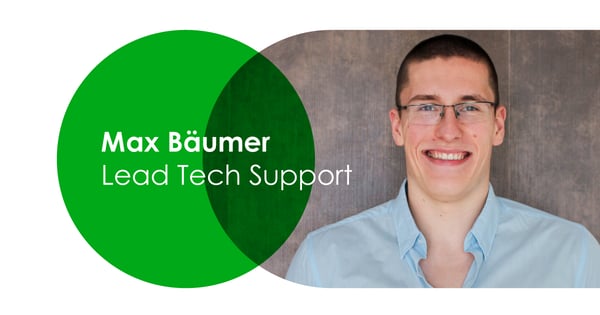
22.12.2022
Meet the Team: Max Bäumer
Name: Max Bäumer Company Role: Team Lead Technical Support --- What do you do at Omnia Retail? I manage the Technical Support team. What is something people in your industry have to deal with that you want to fix?...
Name: Max Bäumer Company Role: Team Lead Technical Support --- What do you do at Omnia Retail? I manage the Technical Support team. What is something people in your industry have to deal with that you want to fix? Technical Support is usually the first contact point, when customers are facing issues. From time to time, customers are emotionally triggered during this conversation. In general this does not help solving the underlying issue faster, even worse, it affects us mentally aswell. In general, I would prefer when anyone in the industry is treated with the respect one would like to receive themselves. What is your past experience, of working in your position? Don’t really have any. I kind of tripped, fell and landed at Patagona (now Omnia). And now look where I am :) What do you like about working at Omnia Retail so far? The people are the most important part. Even after Covid forced most people into home office, the connection remained strong. I’m happy to call most people not only my coworkers, but actually friends. I think having this many foodies around, is only one of the reasons. Besides, I always enjoyed the freedom to try out new things and learn new skills. What are the values that drive you? Food and good sleep. Besides, perhaps respect, compassion / empathy and kindness. What are your top favorite books, podcasts, or documentaries? Eragon, Qualityland and The Kangaroo Chronicles. What do you enjoy doing when you are not working? Eating food big time and doing lots of sports because of the previous point. Let’s end with your favorite quote! “Hinten kackt die Ente” (My Dad)
Meet the Team: Max Bäumer
24.11.2022
Meet the Team: Manuel Zahn
Name: Manuel Zahn Company Role: Team Lead of Team Constellation --- What do you do at Omnia Retail? My team and I handle the planning, implementation, and acceleration of dataflows in our pricing platform. Every day, we...
Name: Manuel Zahn Company Role: Team Lead of Team Constellation --- What do you do at Omnia Retail? My team and I handle the planning, implementation, and acceleration of dataflows in our pricing platform. Every day, we process hundreds of millions of data points, such as offers and price recommendations. What is something people in your industry have to deal with that you want to fix? Traditionally, in the software industry, we have to manage infrastructure, which distracts from focusing on the actual product. I encourage you to consider serverless architectures, where the cloud provider takes care of the infrastructure, and you can save time and invest it in your core product. What is your past experience, of working in your position? I studied computer science and economics at TU Darmstadt. During that time I worked as a research assistant in the Multimedia Communications Lab (KOM) in Darmstadt. There my main focus was researching and lowering the energy consumption in smartphones. I’ve also had a six month internship at NEC Laboratories Europe, where I researched about automated configuration of cloud-based IoT platforms. Soon I joined Omnia as a working student in 2014 :) What do you like about working at Omnia Retail so far? What I like most about Omnia Retail are the awesome people. There is always a friendly and constructive atmosphere which is the baseline for growing. Due to the large variety of tasks, the everyday work never gets boring. What are the values that drive you? Curiosity and Creativity What are your top favorite books, podcasts, or documentaries? - Methodisch Inkorrekt (Podcast) - Geschichten aus der Geschichte (Podcast) - A Journey Beyond (Documentary) What do you enjoy doing when you are not working? I’m passionate about cycling. In every season. I’m a fan of bikepacking. This means bicycle adventures on a Gravel Bike with minimum baggage plus tent. So far I cycled through the Alps, Scandinavia and Spain/France. Who is in for the next level of adventure? Let’s end with your favorite quote! “The Sky's the Limit” by Captain Picard in the final episode of Star Trek TNG
Meet the Team: Manuel Zahn
24.11.2022
Meet the Team: Elisa Mozena
Name: Elisa Mozena Company Role: Senior Corporate Recruiter --- What do you do at Omnia Retail? As a Sr Corporate Recruiter, I hire new Omnians to help further build our teams. What is something people in your industry...
Name: Elisa Mozena Company Role: Senior Corporate Recruiter --- What do you do at Omnia Retail? As a Sr Corporate Recruiter, I hire new Omnians to help further build our teams. What is something people in your industry have to deal with that you want to fix? I know recruiters sometimes have a bad reputation and this is one of the goals I have in my career - I want to have a positive impact on every candidate I meet with, independently of the interview outcome. We’ve all been candidates once, including myself, and I know how stressful and time consuming looking for a new job can be. What is your past experience, of working in your position? Before becoming a recruiter I worked for a time at the Finance department of a Hotel (it was not for me), and before that I was a Chef. I worked in Michelin-star restaurants and came quite a long way but at certain point I wanted to develop intellectually and decided to go back to study. I followed a BA degree in Amsterdam and as part of it I did an internship in recruitment. I fell in love with recruitment and have been in this field ever since. What do you like about working at Omnia Retail so far? The people - I love working with inspiring, smart and driven people. A players attract A players ;) What are the values that drive you? I link to think I match with all of our values, but Obsession with Excellence comes first. It’s different than being a perfectionist. There is no such a thing as “perfect”. Obsession with Excellence is about improving, always doing your best, and having high standards. What are your top favorite books, podcasts, or documentaries? I listen to Brazilian Podcasts, it’s the easiest way I have found to stay in touch with my culture. Regarding books, my no1 will always be Harry Potter, All the Light We Cannot See, The Outsider. What do you enjoy doing when you are not working? When I’m not working I’m doing crochet, spending time outdoors, or taking dance classes. Let’s end with your favorite quote! A smooth sea never made a skilled sailor (it’s actually a Brazilian quote).
Meet the Team: Elisa Mozena
27.10.2022
Meet the Team: Srinivas
Name: Srinivas Sista Company Role: Operations Process Manager --- What do you do at Omnia Retail? I am a part of the Operations team and work on projects that need processes and structure. What is your past experience,...
Name: Srinivas Sista Company Role: Operations Process Manager --- What do you do at Omnia Retail? I am a part of the Operations team and work on projects that need processes and structure. What is your past experience, of working in your position? I started my career as an analyst and then worked in ecommerce startups in SouthEast Asia for five years mainly in the Operations teams including 3 years as a cofounder of an ecommerce startup. After I moved to the Netherlands I worked in a social media agency, founded a micro mobility startup, worked as a freelancer in a content team, a postman and a sales development representative before joining Omnia. What do you like about working at Omnia Retail so far? I like the work culture - the culture of feedback and being able to speak openly yet professionally. What are the values that drive you? Mutual respect and the right to find happiness. What are your top favorite books, podcasts, or documentaries? TED Talks, Books by Aldous Huxley ( essays) and mostly fiction. BBC Earth as a documentary is great. What do you enjoy doing when you are not working? Walk my dog, spend time with family or play chess.
Meet the Team: Srinivas
24.08.2022
Meet the Team: Brend
Name: Brend Kolfschoten Company Role: Junior Consultant --- What do you do at Omnia Retail? Enjoying a lot what I’m doing within the company and getting to learn a lot while doing it. Within Customer Success team I’m a...
Name: Brend Kolfschoten Company Role: Junior Consultant --- What do you do at Omnia Retail? Enjoying a lot what I’m doing within the company and getting to learn a lot while doing it. Within Customer Success team I’m a supportive partner for all the companies connected to Omnia. Making sure that everyone gets the most out of the system. What is something people in your industry have to deal with that you want to fix? Creating an environment where there is room for creativity and a lot of testing. Due to the growth of online stores, Dynamic Pricing became more relevant than ever. Making it possible for companies to change prices on a more regular base. By taking away any restrictions the data or any analysis could pose. What is your past experience, of working in your position? Before starting at Omnia I’ve finished a master degree in Data Driven Business. After finishing the degree I’ve worked on forecasting methods in which Dynamic Pricing would be one of the key factors for determining the results. While studying I have built up experience in Customer success, Customer support, and sales within several different industries. What do you like about working at Omnia Retail so far? Every day is completely different. Making it an interesting work environment where there are a lot of things to learn. Working in a really diverse team but having the drivers for working at Omnia. Different members within the teams all have their own field of knowledge making it a place where we could learn from each other. Noticing also that I’m working with smart people all around me. What are the values that drive you? Empathy, Courage, Determination and Curiosity What are your top favorite books, podcasts, or documentaries? - Boook:The Tipping Point: How little things can make a big difference - Malcolm Gladwell - Documentary: The last dance - docuseries on the rise of superstar Micheal Jordan - Song: A horse with no name - America What do you enjoy doing when you are not working? I’m a musician and playing within 2 different bands. Having about 40 performances a year all over the Netherlands. Being an entertainer on stage and really giving and receiving energy from the crowd. To make sure I have the energy to jump around the stage for a few hours I’m also a big fan of sports. My main sport is Cross-fit but I like to pick any challenge by changing up the sports I’m doing like: Football, basketball, beach volleyball, bouldering and squash. Let’s end with your favorite quote! “Life is like a box of chocolates, you never know what you’re going to get” - Forrest Gump
Meet the Team: Brend
13.07.2022
Meet the Team: Dennis
Name: Dennis Koschinski Company Role: Backend Developer --- What do you do at Omnia Retail? The team and I take care that our web crawlers download millions of offers every day. What is something people in your industry...
Name: Dennis Koschinski Company Role: Backend Developer --- What do you do at Omnia Retail? The team and I take care that our web crawlers download millions of offers every day. What is something people in your industry have to deal with that you want to fix? We have to monitor millions of multivariate data points every day. The analysis is a complex task that can easily overwhelm somebody. I would like to make this task easier, which could help people focus on the more important problems. What is your past experience, of working in your position? I joined Patagona (Omnia) directly after finishing university, where I studied Physics with a focus on the characteristics of solid state matter. During my studies I worked as a scientific assistant in Solid State NMR Spectroscopy, which gained me some experience in data analysis and computational quantum physics. What do you like about working at Omnia Retail so far? What I like most about Omina Retail is that I can work together with smart and funny people on challenging topics that don’t bore me. What are the values that drive you? Respect and kindness What are your top-3 favorite books? - Lord of the Rings, J.R.R. Tolkien - Modern Quantum Mechanics, J.J. Sakurai - The Glass Bead Game, H. Hesse What do you enjoy doing when you are not working? I cook tasty food or listen to music. Let’s end with your favorite quote! “The measure of greatness in a scientific idea is the extent to which it stimulates thought and opens up new lines of research.” Paul Dirac, 1968
Meet the Team: Dennis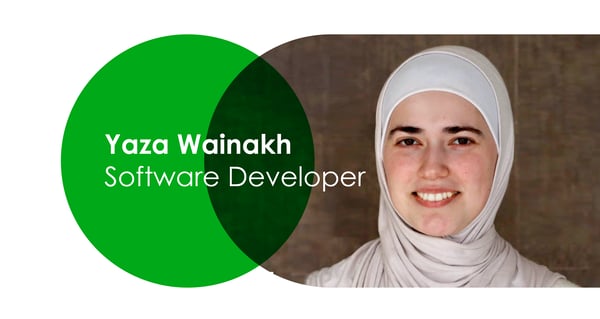
14.06.2022
Meet the Team: Yaza
Name: Yazah Wainakh Company Role: Software Developer --- What do you do at Omnia Retail? Supporting the Frontend part of Omnia products. Mainly trying to create an enjoyable and fruitful experience for our customers :)...
Name: Yazah Wainakh Company Role: Software Developer --- What do you do at Omnia Retail? Supporting the Frontend part of Omnia products. Mainly trying to create an enjoyable and fruitful experience for our customers :) What is something people in your industry have to deal with that you want to fix? I think there is a general misconception when it comes to Frontend development, where mostly it is thought of as creating user interfaces and fixing colors and alignments. While UI is at the core of our responsibilities, there is, on the other hand, a lot that goes on behind the scenes that enables a web page to look and behave as you see it. From data structuring, processing, storing to ensuring a high quality performance, all are parts of a frontend developer’s toolkit. What is your past experience, of working in your position? I studied Software Engineering in three different countries between Bachelor and Masters, naming Syria, Jordan and Germany. This enabled me to see how people from different backgrounds address issues and handle challenges.. I have worked in different part-time jobs while studying, varying from software development to research assistance. Then I landed my first full-time job at Patagona (now Omnia). What do you like about working at Omnia Retail so far? The transparency within Omnia. The friendly environment where one can speak-up their mind freely. The support among the team members to learn and grow, because at the end of the day a team is only as strong as its least experienced member. It is therefore essential to participate in the growth of each team-member. What are the values that drive you? Compassion, Integrity, Determination, Self-growth. What are your top-3 favorite books? - The sky wept fire - by Mikail Eldin - The power of now - by Eckhart Tolle - Outliers - by Malcolm Gladwell What do you enjoy doing when you are not working? I enjoy a nice walk in nature, spending time with family and friends, and I always have a book nearby to be explored. Currently “still” trying to learn German. Also, a tv-show is mostly to slip in here and there. Let’s end with your favorite quote! I will share two quotes that pop a lot in my head, “Happiness is an inside job” by William Arthur Ward ”If you don't like where you are, move! You are not a tree” by Jim Rohn
Meet the Team: Yaza
24.05.2022
Meet the Team: Tim
Name: Tim Avemarie-Scharmann Company Role: Head of Knowledge & Scalability --- What do you do at Omnia Retail? I help our customers to define and achieve their commercial pricing goals, by building our customers' and...
Name: Tim Avemarie-Scharmann Company Role: Head of Knowledge & Scalability --- What do you do at Omnia Retail? I help our customers to define and achieve their commercial pricing goals, by building our customers' and internal team's pricing and retail expertise in a sustainable and scalable way. What is something people in your industry have to deal with that you want to fix? Competitive positioning and pricing are complex issues, and also a necessity for every entrepreneurial organisation. In the digital E-Commerce this is even more true, as data and information are available all the time, both to the consumer as well as to competitors. I want to provide our users with the most relevant industry knowledge on pricing, and help them apply the most efficient solution. What is your past experience, of working in your position? I studied Sociology, Politics and Philosophy and used to work in Singapore for some time after my studies. The major part of my professional life I have been working in a SaaS company in the E-Commerce industry, dealing with questions related to (dynamic) pricing. I also serve as municipal councillor in my city Mainz for the pan-european party Volt, where I get engaged with local questions related to global issues like climate change or the technological disruption. I am very much interested in the intersections of different things, e.g. where the technological meets the social or the political meets the economical. I like to deal with different questions in varying contexts, as it challenges me to learn something new and to grow, but also to come up with new ideas and innovative solutions. What do you like about working at Omnia Retail so far? With many of my colleagues I have been working together for the better part of all of our professional careers. Many of us have started during or right after university. We all grew together and everybody became more skilled in what s/he is doing, may that be coding or working with our customers. To see that we all evolved professionally and personally, becoming friends that care for each other along the way, and being able to produce valuable solutions for the biggest and most renowned brands and retailers in Europe, is something that makes me proud and wistful. And after merging with Omnia, there is a big bunch of new interesting people that I am really excited to work with and learn from in the years to come. What are the values that drive you? Positivity and caring for the people around me. What are your top-3 favorite books? - The Silmarillion - J.R.R. Tolkien - Sapiens: a brief history of humankind - Yuval Noah Harari - Beerholms Vorstellung - Daniel Kehlman What do you enjoy doing when you are not working? I like to work out, but I am not sure if that qualifies as “not working” ;-) As my daughter just turned 2, I spend a lot of time on playgrounds. When there is enough time on the weekend we usually go on family trips. It´s such a great thing exploring and experiencing the world around you with your kids, it brings a completely new quality to it. Let’s end with your favorite quote! "Technology is society made durable" - Bruno Latour
Meet the Team: Tim
25.04.2022
Meet the Team: Milena
Name: Milena Shayan Company Role: Customer Success Manager --- What do you do at Omnia Retail? It’s hard to narrow it down :) My team and I are the first contact point for our customers. We do the technical support,...
Name: Milena Shayan Company Role: Customer Success Manager --- What do you do at Omnia Retail? It’s hard to narrow it down :) My team and I are the first contact point for our customers. We do the technical support, workshops, and consulting. Besides that I do routine check-ups, proactive support and different projects to improve the internal & external processes. Other than that, I’m helping out wherever it’s needed, for example, Office Management, Accounting, Organizing little after work get-togethers with coworkers. What is something people in your industry have to deal with that you want to fix? In my day to day work I deal with a lot of customers and different accounts and support a lot of users with their challenges. What I really have learned is that looking at every challenge with respect and comprehension, to solve the issues and help our customers. I want to set an environment that relies on mutual respect and is conducive to problem solving. What is your past experience, of working in your position? Before I started working at Patagona (Omnia now), I helped in my parents' lab at the time and already had a lot of contact with customers. My studies in industrial engineering with a specialization in mechanical engineering, taught me besides technical thinking a lot about different soft skills like handling stress, being organized and disciplined. I’m glad that I was able to gain experience in many different areas within the company, from cold calling, sales, accounting, direct contact at fairs and more. So the last past almost 6 years I built a lot of know-how and best practices for my actual position within the customer success department. What do you like about working at Omnia Retail so far? On one hand, as e-commerce is constantly changing and evolving, we as a SaaS company are also always challenged to evolve. I have always had the freedom to delve into different areas and aspects and learn a lot of new things. On the other hand, I find that the friendly and supportive environment is not only encouraging but also makes working at Omnia fun. What are the values that drive you? Kindness, Creativity, Acceptance What are your top-3 favorite books? It’s usually hard for me to pick favorite books because they change over time. - Ikigai - Ken Mogi Two books I just started to read and already like a lot: - Who am I and if so how many? - Richard David Precht - The vegetarian - Hang KangBlink - Malcolm Gladwell What do you enjoy doing when you are not working? I like to paint, go to exhibitions (the most recent one was the Renoir - Rococo Revival), spend time with friends, and do some gardening. Let’s end with your favorite quote! "As time goes on, you’ll understand. What lasts, lasts; what doesn’t, doesn’t. Time solves most things. And what time can’t solve, you have to solve yourself." - Haruki Murakami
Meet the Team: Milena
25.04.2022
Meet the Team: Hector
Name: Hector Rubin Company Role: Junior Consultant Trainee --- What do you do at Omnia Retail? Learn, mostly! As a part of the traineeship program, I rotate through several different teams within Omnia. Starting with...
Name: Hector Rubin Company Role: Junior Consultant Trainee --- What do you do at Omnia Retail? Learn, mostly! As a part of the traineeship program, I rotate through several different teams within Omnia. Starting with customer success, but moving on to sales, product and working in a consultancy function as well. Currently, I’m handling client support requests and dipping my toes in the customer success realm. Most of my day-to-day activities revolve around understanding the intricacies of Omnia, common customer issues, and solving unique challenges (really, puzzles) that arise for our clients. I’m also responsible in part for making sure that the company is up to speed in the morning, so rising early is part of the job too! What is something people in your industry have to deal with that you want to fix? Information overload; there’s so much information coming at you from every angle, concerning a huge variety of topics. It becomes exceedingly difficult to remain organised and properly digest the necessary information as it comes. I find that this is especially prevalent in documentation; it is essential, but can quickly become hindersome if not well thought out. What is your past experience, of working in your position? I’ve worked in a number of positions before coming to Omnia, mostly throughout my studies. Almost all of my positions had some element of customer success/management, as a librarian, cocktail bartender, and pharmaceutical bike courier. Always important to keep the customers happy! I believe that my varied interests, good attitude, and open mind towards challenges are important credentials for my position. Besides those attributes, I hold a MSc in Entrepreneurship and Business Development from Maastricht University where I graduated cum laude. I also hold a BA in European Studies from Maastricht University. Studying always helps! What do you like about working at Omnia Retail so far? The environment, the people, and the challenges. I feel like I fit right in with the culture, which has made my transition very easy. Everyone here is open, informed and more than willing to help; without these things, I would certainly be more lost! Besides the mass of collective knowledge, my colleagues are genuinely wonderful people. After meeting our fantastic colleagues over in Darmstadt, I was convinced that everyone really has each other's best interests in mind. Finally, the challenges and learning curve has been a very appealing aspect of the work so far. Slowly gaining more competence and responsibility is a very satisfying feeling, and I’m looking forward to the day where I can call myself a ‘product expert’! The skills and knowledge I’m gaining at Omnia are extremely useful and I’m looking forward to continually developing myself. What are the values that drive you? Honesty, Genuineness, Self-reflection, Kindness What are your top-3 favorite books? -Blink - Malcolm Gladwell - Kitchen Confidential - Anthony Bourdain - A promised land - Barack Obama What do you enjoy doing when you are not working? I’m an avid runner, so you might find me looping around Vondelpark after work. Otherwise, I enjoy drawing, journaling and learning new languages. I’ve recently been working on my German. A good book never hurts either. Let’s end with your favorite quote! “If you talk to a man in a language he understands, that goes to his head. If you talk to him in his own language, that goes to his heart.”
Meet the Team: Hector
22.03.2022
Meet the Team: Marielle
Name: Marielle Roozendaal Company Role: Employee Experience Manager --- What do you do at Omnia Retail? Together with Vanessa (COO of Omnia Retail) we work on creating a scalable and professional organization and...
Name: Marielle Roozendaal Company Role: Employee Experience Manager --- What do you do at Omnia Retail? Together with Vanessa (COO of Omnia Retail) we work on creating a scalable and professional organization and building an engaging high performance company culture. My passion is to drive great employee and vistors experience. This is very varied, from working on different projects such as joining Amsterdam Inclusive and Diversity. But also looking for the right tools like e-Signing or HRIS. I am also responsible for the complete people administration, (home) office, organize team meetings and awesome events. What is something people in your industry have to deal with that you want to fix? Engage and connect employees. A lot has changed, especially in the past 2 years. Many companies have started working from home and are likely to continue to do so. As a result, employees mainly see each other online and no longer physically. It is important to take this into account and do everything you can to stay in touch and take care of each other.. What is your past experience, of working in your position? I have completed Media & Entertainment Management study. One of the things I learned is to plan and organize events in all kinds of areas. After that I started working as a study advisor at a company that offered training to companies and individuals. Something that had nothing to do with what I learned during my study. But at that time I wanted to work and live closer to my family and friends, so this was for a short term. After that I started at a start-up as Office Manager. I learned a lot at this company. Here I found out what I find important in my role and the company where I work. An open and transparent company where we can learn from each other. Then I came to Omnia where all this is the case and what is the right place for me. What do you like about working at Omnia Retail so far? The responsibility I get, the people and the culture. We have a strong feedback culture so I know what I can still learn and improve, but also what goes well. This allows me to bring out the best in myself. We have a great team that is always open to help and improving each other. What are the values that drive you? Honesty and Respect. What are your top-3 favorite books? - Book: The Culture Map - Erin Meyer - Podcast: People Masterminds What do you enjoy doing when you are not working? Spending time with my family and friends. Working with my hands (wooden furniture or games, crochet). I recently bought a racing bike, so this spring I’m starting cycling! Let’s end with your favorite quote! “Just do it.”
Meet the Team: Marielle
17.03.2022
Meet the Team: Andreas
Name: Andreas Frankenberger Company Role: Chief Technical Officer (CTO) --- What do you do at Omnia Retail? Shaping our platform in a way that enables us to fulfill the future needs of our customers and fostering the...
Name: Andreas Frankenberger Company Role: Chief Technical Officer (CTO) --- What do you do at Omnia Retail? Shaping our platform in a way that enables us to fulfill the future needs of our customers and fostering the development teams to be prepared for the upcoming challenges. What do you like about working at Omnia Retail so far? Having discussions with very talented people on topics such as pricing, software architecture and software development in general. What are the values that drive you? Always learning new things. What are your top-3 favorite books? - "Misbehaving" by Richard Thaler - "Und Nietsche weinte" by Irvin D. Yalom - "Jerusalem" by Sami Tamimi & Yotam Ottolenghi What do you enjoy doing when you are not working? I enjoy cooking with friends and hope I find more time for sports such as weight lifting, grappling and bike riding. If I’m not at sport or cooking in the evening I read a book. Besides of this, I like not tying my shoes, according to my girlfriend ;)
Meet the Team: Andreas
22.02.2022
Meet the Team: Nik
Name: Nik Shulrufer Company Role: Software Developer --- What do you do at Omnia Retail? Supporting the Frontend part of the Omnia portal, transforming lines of code into nice new features for our customers and ensuring...
Name: Nik Shulrufer Company Role: Software Developer --- What do you do at Omnia Retail? Supporting the Frontend part of the Omnia portal, transforming lines of code into nice new features for our customers and ensuring that everything runs as smoothly and reliably as possible :) What is something people in your industry have to deal with that you want to fix? The world of software development is rapidly changing. Each day new technologies emerge, existing technologies get overhauled and so on. Therefore, if developers do not factor in the possibility of future changes, they will eventually find themselves stuck in the maintenance mode, instead of the mode of creation. Why? Because the biggest challenge for a software engineer is not to write a code which will bring about a certain result. It is writing a code that will be robust enough as to outlive hundreds of iterations without breaking anything and clear enough so it can be easily understood by others even after a few years. Only then you can call this a ‘good code’. What is your past experience, of working in your position? Holding a bachelor’s degree in law (yes, completely unrelated to tech), I started out as a self-taught developer several years ago out of sheer passion for creating things on the web. Since then, I familiarized myself with intricacies of Frontend programming languages, frameworks and tools which now allow me to build beautiful stuff for Omnia. What do you like about working at Omnia Retail so far? The friendly vibes and a pleasant environment to work in created by the awesome people at Omnia. In addition, it is also a huge opportunity for professional growth that Omnia offers. What are the values that drive you? Integrity – paramount to any social interaction and the foundation of every relationship. Consistency – the main ingredient for any growth or success, especially if coupled with a reflection and smart adjustments along your journey. What are your top-3 favorite books? Hard to pick only three, but below are some really good ones: - “The End of Eternity” by Isaac Asimov - “Way of the Peaceful Warrior” by Dan Millman - “Obstacle is the way” by Ryan Holiday What do you enjoy doing when you are not working? All kinds of sport ignite a spark inside me. Be that scuba diving, skiing, or mountain biking – count me in for the game. I also do not neglect a regular weightlifting to live by the famous adage – Mens sana in corpore sano. Let’s end with your favorite quote! “If one does not know to which port one is sailing, no wind is favorable.” — Seneca
Meet the Team: Nik
21.02.2022
Meet the Team: Ola
Name: Ola Aboamer Company Role: Lead Frontend Developer --- What do you do at Omnia Retail? Supporting the team in all Frontend deliverables, collaborating towards team growth, and developing the UI of the company's...
Name: Ola Aboamer Company Role: Lead Frontend Developer --- What do you do at Omnia Retail? Supporting the team in all Frontend deliverables, collaborating towards team growth, and developing the UI of the company's software products to deliver the best user experience for our customers. What is something people in your industry have to deal with that you want to fix? Perhaps I did not face something yet that I can say I want to fix for the Software development industry, improvements are very fast ongoing in the software industry, but in general, it interests me how the automation of some development processes (e.g UI testing automation ) can massively save time and efforts and avoid faults during manual testing. What is your past experience, of working in your position? Starting from 2011 and after my graduation from faculty of science- mathematics/computer science major I have been enrolled in a 9-month program internship for open source development, during that program I got introduced to frontend/backend foundations, I began my journey with development, first, as a backend developer, then I moved to work as a software engineer at CERN (European Organization for Nuclear Research) in Switzerland, for 2 years there I was the database group convener, responsible for communicating all stakeholders (Leaders, scientists, CERN IT ) in order to design/build a database also participated in design and building web-based monitoring system for one of the sub-detectors in CMS experiment. I am passionate about continuing sharing my experience in order to develop in Omnia’s success endeavor. What do you like about working at Omnia Retail so far? Collaborative, team-oriented environment and easy going intercommunication. Everyday one learns new thing(s). What are the values that drive you? Kindness - Learning - Collaboration - Clarity - Achievement. What are your top-3 favorite books or podcasts? Podcasts: - The road ahead cafe - Gratitude blooming Books: - Azazel by Youssef Ziedan - The Subtle Art of Not Giving a F*ck by Mark Manson - The Development of Quantum Mechanics by Paul Dirac What do you enjoy doing when you are not working? Assuming “not working” state coincidences with my daughter in kindergarten then I do Reading/Writing - Painting - go to Gym , otherwise practicing parenthood. Let’s end with your favorite quote! “Be yourself; everyone else is already taken.” – Oscar Wilde
Meet the Team: Ola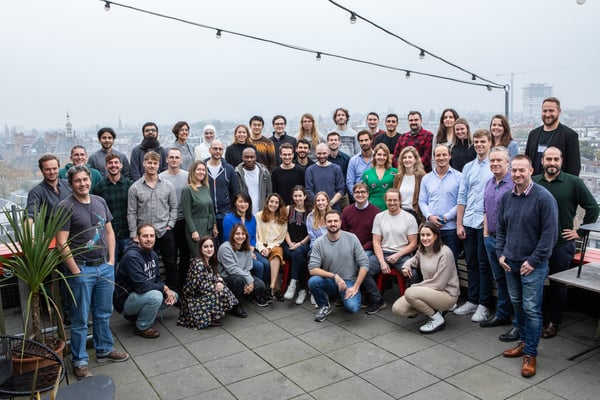
17.11.2021
Omnia acquires Patagona to become leading pricing software provider
This Thursday Omnia Retail announced the acquisition of German pricing software provider Patagona. Both companies are specialized in dynamic pricing software and with the integration Omnia will become Europe’s leading...
This Thursday Omnia Retail announced the acquisition of German pricing software provider Patagona. Both companies are specialized in dynamic pricing software and with the integration Omnia will become Europe’s leading enterprise pricing solution. "By combining our strengths, the new holding is the leading B2C-retail dynamic pricing vendor in Europe." Omnia founder & CEO Sander Roose will become the group CEO. Patagona’s founders Andreas Frankenberger and Maximilian Bank will become group CTO and CCO, respectively. Sander Roose’s view on the future of the company: “COVID driven e-commerce acceleration has increased the need for dynamic pricing software for retailers and brands in all product categories. By combining our strengths, the new holding is the leading B2C-retail dynamic pricing vendor in Europe. This step also guarantees a strong local presence in the crucial DACH region. Our main focus is further improving our service level to retailers and brands by accelerating product development. With the addition of the Patagona team, we have all the required expertise to ensure our customers can leverage the power of machine learning (AI) for pricing insights and price optimization, which is a key product priority for the coming years.” "Leading the way together with a strong, ambitious and dynamic company that shares the same values." Andreas Frankenberger and Maximilian Bank believe that the effect of joining forces will have a very positive impact on the customer side: "To provide our customers with the best possible solution - in data quality as well as retail know-how - we are committed to leading the way together with a strong, ambitious and dynamic company that shares the same values as Patagona: Omnia Retail." The group raised growth financing provided by ABN Amro, which enables the group to invest more heavily in the continuous development of the platform. The funding allows the company to take a large step forward towards reaching its ultimate goal of becoming the global market leader in retail pricing software. SaaS investor Connected Capital & Partners remains on board and continues to be an important strategic partner for the company's further growth. Both companies plan to operate as one company, with locations in Amsterdam and Darmstadt. The combined leadership team is an important first step in that direction. Omnia and Patagona's customers can continue to rely on both companies' products as those will continue to exist. About Omnia Retail Omnia’s software uniquely combines dynamic pricing automation with various market data sources, from platform data like Google Shopping and Amazon to direct scraping. The company has over 15 years of retail and pricing experience, which makes them experts in guiding its customers on their path towards more pricing maturity. Omnia's customers include Decathlon, Bol, Signa Sports, Media Markt, De Bijenkorf, Philips, Samsung and Accell Group. About Patagona Patagona develops software-based e-commerce solutions. With its main products, Patagona enables online retailers to optimize their sales prices automatically and helps brands to get a global market overview of their product prices online. Using deep technical AI in their software solution, customers like METRO, Kaufland, Intersport, L’Oréal and LVMH benefit from their pricing expertise. Talk to one of our consultants about dynamic pricing. Contact us
Omnia acquires Patagona to become leading pricing software provider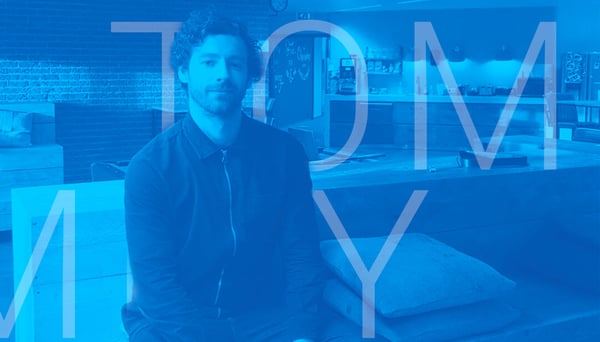
21.04.2021
Meet the Team: Tommy
Name: Tommy Hackley Company Role: Junior Consultant --- What is your favourite quote? “The more I learn, the more I realise how much I don’t know” What is your top-3 favorite books or podcasts? My two favourite books...
Name: Tommy Hackley Company Role: Junior Consultant --- What is your favourite quote? “The more I learn, the more I realise how much I don’t know” What is your top-3 favorite books or podcasts? My two favourite books come from my two favourite authors, they are The Executioner’s Song by Norman Mailer and The Brother Karamazov by Fyodr Dostoevsky. The first written with style and whit, contemplating questions of life, death and capital punishment. The second contemplates just about everything to do with human nature. My favourite podcast is The Football Ramble - an English podcast about… football! Started by a few mates who liked football in a bedroom just over 10 years, the show has risen to the number one sports podcast in the UK. What do you do at Omnia Retail? I’m a Junior Consultant enrolled in the Traineeship. I’m currently in my Sales rotation, having cut my teeth in Support. What is something people in your industry have to deal with that you want to fix? Much of the work that is being done is very manual, which is time consuming and inefficient. It can be manually checking competitor prices, manually making changes to feeds connected to pricing solutions or just about anything else. This work is often repetitive and highly error prone. Moving towards as much automation as possible with these tasks is the holy grail, freeing individuals up to concentrate their efforts on more impactful work. What are your credentials/past experience, for working in your position? Before joining Omnia I ran the family business - a coffee bar in Birmingham where I learned discipline, resilience, self-resolve and determination. Before that I studied law in London, during which time I was a mentor teaching debating in prisons and a legal representative for a South American Cleaner’s Association. Before that I studied Business in Manchester. What do you like about working at Omnia Retail so far? I like ‘grafting’. Being in a scale up environment, there’s plenty of building and plenty of responsibility, which helps me thrive. I love being surrounded by my incredibly gifted teammates who inspire me everyday, who I can learn so much from and who drive me to be better. I also like helping customers, whether that be with ad-hoc support issues that arise, in a more strategic setting or indeed with new potential customers. I like finding solutions to customers’ specific needs. What are the values that drive you? Integrity, accumulating Knowledge and Passion. What do you enjoy doing when you are not working? My passions are sports and music, watching, listening and playing. Beyond that I love cooking, reading, trying new foods & drinks and having a laugh.
Meet the Team: Tommy
15.03.2021
Meet the Team: Marwa
Name: Marwa Lamouni Company Role: Junior consultant What is your favourite quote? ‘Just keep swimming’ - Dory in ‘Finding Nemo’ What are your top-3 favorite books or podcasts? The Black Swan - Nassim Nicholas Taleb I...
Name: Marwa Lamouni Company Role: Junior consultant What is your favourite quote? ‘Just keep swimming’ - Dory in ‘Finding Nemo’ What are your top-3 favorite books or podcasts? The Black Swan - Nassim Nicholas Taleb I really loved this book because it shows how big the impact of the highly improbable events in your life can be. The author supports his thesis with interesting examples that can (almost) make everybody love probabilities. The Prophet - Khalil Gibran It’s about the life lessons that a prophet shares with the people of his town, before he moves on to a new adventure. I would say that this book is my all-time feel-good book. It is a short read but it is a gold mine of profound insights. Walden - Henry David Thoreau This is a classic of American literature. It’s the diary of Thoreau when he decided to move to the wild for two years. He even went so far as to build his own shelter and grow his own food. I enjoyed reading it because the author perfectly describes his quest to connect with nature. What do you do at Omnia Retail? I have joined Omnia as part of the traineeship program. My first rotation is in the Customer service team where I get to interact directly with our valued customers. So you could say I am the face, along with my fellow trainees, behind the Customer Service at Omnia. It is a privilege indeed to get to know our clients, but also be able to help and guide them in their Omnia journey. What is something people in your industry have to deal with that you want to fix? I believe that being able to tailor your pricing strategy to better encompass your needs and expectations is key to achieving long-term success. However, what we are seeing today is that many companies do not have the tools necessary to do so. I find that, armed with the right tool, and pertinent knowledge, retailers can do wonders. What are your credentials/past experience, for working in your position? I hold a Bachelor’s degree in Business Administration with a major in Finance and International Business. However, I found myself more drawn to International Business so I decided to move to Paris to pursue a Masters in that field. I was lucky enough to work for different companies and industries during my studies. Indeed, I worked as a marketing assistant at Ferrari, but also at Canal+ as a Customer Experience analyst. These have enabled me to build up a customer-oriented mindset, which empowers me further in building connections with our clients. What do you like about working at Omnia Retail so far? There is no room for the mundane. Every day brings in new challenges that help you build in your knowledge. Also, we are always encouraged to think outside of the box by providing creative solutions to our customers. I also love the fact that one’s inputs and ideas are always valued. What are the values that drive you? Proactiveness, resilience, and empathy. What do you enjoy doing when you are not working? I love to read, some people might even say that I would be your typical book nerd. I don’t have a specific favorite genre, I am usually curious about different topics so luckily I can always find a book to read. I am currently reading ‘War and peace’ by Tolstoy, as I am finding myself drawn to Russian literature lately. I also do yoga, and go swimming (when swimming pools are open :) I also recently started playing around with watercolor painting.
Meet the Team: Marwa
23.02.2021
Understanding and Using Market Penetration Strategies
Did you start a brand to see it lose momentum or market share to competitors? It’s a silly question to ask owners yet a number of brands make mistakes within their chosen market. At times, it’s not a matter of what...
Did you start a brand to see it lose momentum or market share to competitors? It’s a silly question to ask owners yet a number of brands make mistakes within their chosen market. At times, it’s not a matter of what you’re doing but what a brand is not doing that impedes opportunity for growth. That’s where market penetration strategies come to play. What’s a common characteristic of powerful brands? They increase market share and continue to seize opportunity. But, realizing business success requires a continual growth strategy. In this guide, you’ll learn how to: Gain a better understanding of market penetration strategies Read market penetration examples Get tips regarding the best marketing penetration strategies What Is Market Penetration? Market Penetration Definition The term market penetration adopts a theoretical and literal meaning. On one hand, a brand calculates market penetration to gain a sense of the size of a market and what percentage of consumers buy its products and services within. In the literal sense, market penetration is the actions taken to overtake competitors and gain a larger share of the market. Market penetration is the percentage of products/services sold in relation to the estimated total market. Theoretically, a brand wants to eliminate all competition, completely owning all the market share for a given product or service. Calculating the entire market size and estimating how much of the pie you own is incredibly useful for new and established brands. Market Penetration Rate A simple equation related to market penetration: (Number of customers/Size of market) x 100 = Market Penetration Rate For example, assume 500 million people live in a country, and 100 million of them own an iPhone. 100/500 x 100 = 20% penetration rate So, the market penetration for iPhones would be 20%. Theoretically, 400 million people or the remaining 80% of the population remains for the taking. An above average market penetration rate for consumer goods is estimated to be between 2% and 6%. A good penetration rate for business products is between 10% and 40%. Some brands calculate market penetration every quarter while others find it useful to do so after each ad and marketing campaign. High Market Penetration As you can imagine, most brands aspire to an above average or good rate market penetration rate. Having a high penetration rate reaps immediate monetary benefits. In 2018, Amazon’s share of the US ecommerce market was 49% - more than its top three competitors combined! To put it another way, Amazon accounts for 5% of all retail dollars spent throughout the entire United States. In the same year, iPhones captured an estimated 15% to 20% market penetration rate. Apple sold 77.3 million iPhones, finishing the December quarter with a 19.2% share. A brand with high market penetration enjoys immediate riches as well as an ongoing reputation it can continue to leverage. However, the real advantage is enjoying the forward and upward momentum built. Another benefit is that you’re able to set the prices that your competitors follow, rather than you having to follow others. Market Penetration vs Market Share Market penetration is a percentage of a given target market that buys a brand’s products/services. It is distinguishable from market share, which is the portion of total value of a market captured by a brand. Market Penetration Examples Market penetration begins with strategy, yet when applied, leads to actionable steps that achieve stable market dominance. Apple reached a market share of more than 50% of the world market with its smartphones by 2017. Since the inception of the iPhone, Apple consistently released upgrades, enhancements, and accessories. As a result of this market penetration, Apple feasts on a larger market share than all its competitors combined. Dunkin’ started in the 1940s in Massachusetts. Today, the brand formerly known as Dunkin’ Donuts is found in 46 countries. However, its most loyal following remain in New England, for one-third of all Dunkin’ stores reside there. The Coca-Cola brand established itself as a beverage associated with snacks, enjoying the benefits of the refreshment market until tastes began changing in preference of healthier choices. Coke offered Diet Coke to gain a larger share of the beverage market, capturing those more health minded. When market research revealed more women than men preferred Diet Coke, the brand initiated Coke Zero as a ‘catchall’ solution. Best Market Penetration Strategies The actionable part of a market penetration definition relates to actual strategies. Market penetration strategies allow a brand to take its existing product or service to an already thriving market with high demand and begin drawing-in a larger share of the entire market, eventually draining competitors of opportunity and money. Market penetration (as a set of actions) is taken from Igor Ansoff, creator of the Ansoff Matrix. The grid features four growth strategies related to entering a new or existing market with new or established products/services. Get in touch with our pricing consultants to find out more about pricing strategies for your business. Get in touch 1 - Use Dynamic Pricing Many online retailers engage in price wars in an attempt to persuade customers to buy products and services at the best price. The market penetration strategy grows more intense and complicated given online prices rise and drop throughout any given day. Dynamic pricing allows for pricing automation, so regardless of the size or complexity of given products/services, the associated software researches the market and sets prices to deliver actionable intelligence. Further Reading: Why Price Is the Most Important P in the Marketing Mix 2 - Add Distribution Channels Adding distribution channels is another market penetration strategy focused on growth. For example, if a brand solely leverages retail outlets, it may benefit from considering adding other ones such as email marketing, online marketing, and telemarketing. 3 - Target Specific Locations Some products and services are seasonal while others have a greater demand depending on location (A sunscreen brand targeting sunny Los Angeles versus rainy Seattle). Targeting the location in need would lead to a surge in use and increase in sales in that region. 4 - Improve Products If a brand can trace market share to a particular product or service then it would make sense to consider improving upon what the public already likes. Understanding what consumers like (or even better, dislike) about a product presents an opportunity to make it even more loved and preferred depending on technology related to materials, newly developed accessories, etc. 5 - Enter New Geographical Markets The ever-growing spending within the Latin American market has intrigued many brands to expand offerings to Mexican and other Latin American locales. Making the opportunity for growth more a reality, many brands hire Spanish translation services to ensure brand offerings are in Spanish, but also effectively resonate with the Latin American peoples and their culture. A great example of this is when CNET entered the Hispanic market with zeal by partnering with Latin World Entertainment in addition to recruiting well-recognized superstar Sophia Vergara. 6 - Create a Barrier to Entry Wise brands create barriers to entry for competitors by utilizing existing resources or seeking those that would either make a product or service superior or allow to offer such at an unbeatable cost. For example, a food supplier dependent on several farms for production may cut overall costs by investing in its own farm versus buying needed goods from a third party. Amazon continuously reinvests in its customer service, features, and ability to penetrate the market, making it nearly impossible for another online platform to compete. Further Reading: The Complete Guide to Selling on Amazon 7 - Change a Design Water is essential to human life, but only in the last century that it has been offered in plastic bottles. Wine is another example of a beverage that has been around for centuries, yet offering it in a box versus a bottle is a very contemporary market penetration strategy. 8 - Make It Easier to Buy How seamless is your online checkout process? Do you have an online checkout process? Making it easier to find and buy your goods and services is a surefire way to penetrate a greater share of a targeted market. 9 - Create and Recruit Established Advocates Word-of-mouth remains a stellar way to spread word and garner more advocates. Many brands offer membership and/or referral programs. Advocates create support by actively recruiting friends and family, helping the brand penetrate a larger share of the market and make more money. Amazon creates its own internal “club” via Amazon Prime subscription. 26 Amazon Prime Day stats reveals 100 million US shoppers have an Amazon Prime subscription (62% of Amazon’s customer base in the United States)! 10 - Educate the Market For a newer brand entering an established market, the challenge is not creating a want, for it’s already established. The real hurdle is educating the market about a new choice or selection and drawing attention away from brands that already exist. Cabot, makers of cheese, use Pinterest and a variety of social media tools to educate the market on grilled cheese recipes, farms and farmers in their ‘family’ of production, New England ski spots, and healthy options for those who are lactose intolerant. Final Thoughts Ecommerce retailers don’t need to reinvent the wheel regarding the marketing channel. In 2021, it’s more than well established that the opportunity to offer products and services online is there. However, how can e-tailers compete with large competitors such as Amazon? The answer is better understanding market penetration and developing the best marketing penetration strategies to gain a larger share of a targeted market. Curious to learn about some other pricing strategies? Check out some of our other articles below. What is Value Based Pricing?: A full overview of how price and consumer perception work together. What is Charm Pricing?: A short introduction to a fun pricing method What is Penetration Pricing?: A guide on how to get noticed when first entering a new market What is Odd Even Pricing?: An explanation of the psychology behind different numbers in a price. What is Bundle Pricing?: Learn more about the benefits of a bundle pricing strategy What is Cost Plus Pricing?: In this article, we’ll cover cost-plus pricing and show you when it makes sense to use this strategy. What is Map Pricing?: Review our educational tool giving you a broad understanding of MAPs. Here’s What You Need to Know About Psychological Pricing (Plus 3 Strategies to Help You Succeed): Modern day pricing is so much more than a numbers game. When thought about correctly, it’s a powerful way to build your brand and drive more profits. How to Build a Pricing Strategy: A complete guide on how to build a pricing strategy from Omnia partner Johan Maessen, owner of Commercieel Verbeteren.
Understanding and Using Market Penetration Strategies
04.02.2021
Meet the Team: Saskia
Name: Saskia Zoe Mueller-Herbst Company Role: Junior Consultant --- What is your favourite quote? ”A mind that is stretched by a new experience can never go back to its old dimensions.” – Oliver Wendell Holmes Jr. What...
Name: Saskia Zoe Mueller-Herbst Company Role: Junior Consultant --- What is your favourite quote? ”A mind that is stretched by a new experience can never go back to its old dimensions.” – Oliver Wendell Holmes Jr. What is your top-3 favorite books or podcasts? “The Power of Habit” by Charles Duhigg is a great book that explains why habits are at the core of everything we do, what we can do to change them and the impact that change can have on our lives. “How Brands Grow: What Marketers don’t know” by Byron Sharp is a thought-provoking read for everyone interested in marketing principles, like brand growth and how advertising works. “The Boy, the Mole, the Fox and the Horse” by Charlie Mackesy is a beautiful book that I read recently. I can recommend it to everyone who needs a ‘feel-good’ read in uncertain times. What do you do at Omnia Retail? I joined Omnia as a Business Development Representative and was offered to join the Traineeship shortly after. As this is a great opportunity for me to rotate through different departments and experience several aspects of the company, I am really excited about this opportunity. Currently I work in the sales team where I am the first person of contact for our potential new customers. Further, I am also involved in some sales processes and I get to meet great people every day. My next rotation will take me to the Customer Success team where I am looking forward to meeting and interacting with our customers. What is something people in your industry have to deal with that you want to fix? A lot of companies still check and do their pricing manually. That is not only a very time-consuming undertaking, but it can also lead to errors or missing out on relevant insights of the market. Moreover, the right pricing can also give more power to smaller retailers. By always being up to date and having a pricing strategy in place, it gives small and medium sized businesses the chance to compete with the retail and ecommerce giants. What are your credentials/past experience, for working in your position? I have a BSc International Business and a MSc Marketing Management, both from the University of Groningen. During my masters I did an internship at Nestlé, where I was the Marketing Communications Intern for the brand Garden Gourmet. During my study I also worked as a Student Consultant for a Dutch software company. What do you like about working at Omnia Retail so far? I like how much I have learned over the past months. When I look back to when I just started at Omnia I really see how steep the learning curve is, one of the great parts about working at a Scale-up. I really love working with the team, as everyone is friendly and super approachable. While working from home we stay connected through fun online activities and meetings. What are the values that drive you? Open-mindedness, enthusiasm, reliability, and determination are some of the core values that are very important to me. What do you enjoy doing when you are not working? If I would have been asked this question about a year ago my answer would have probably been travelling, meeting up with friends, enjoying an evening out and visiting my family. However, at the moment I really enjoy cooking, reading a good book, going for long walks and watching movies / series from my comfortable couch.
Meet the Team: Saskia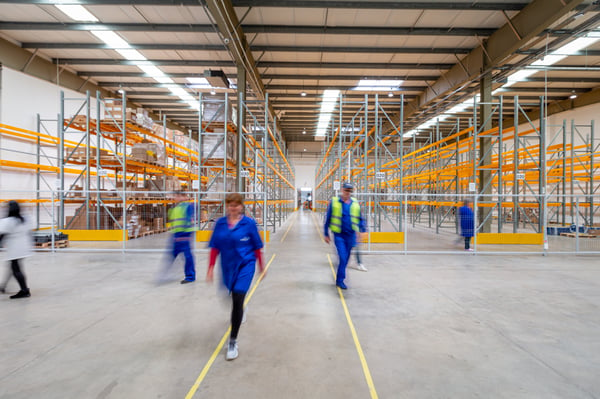
30.12.2020
Amazon is closing in on Dutch competitors
In short: Web giant Amazon is putting Dutch web stores under pressure with rock bottom prices. Thousands of popular products are 7% to almost 18% cheaper at Amazon than at competitors such as Bol.com and Coolblue. At...
In short: Web giant Amazon is putting Dutch web stores under pressure with rock bottom prices. Thousands of popular products are 7% to almost 18% cheaper at Amazon than at competitors such as Bol.com and Coolblue. At the level of the individual articles, large Dutch web shops regularly compete with Amazon. There are several indications that Amazon's market share is growing. You can find a link to the original Dutch articles below this translation. Who will enter the prize fight? Thanks to competitive prices, Amazon has managed to conquer market share and significantly reduced its gap with established rivals such as Bol.com and Coolblue. In the past three months, the American web giant was often the cheapest on a variety of products, according to an analysis that we did for the Dutch news channels BNR and the FD. In 2019, web giant Amazon opened their Dutch web store, after years of speculating. After that it became quiet around the Americans, but nine months later the Amazon effect is clearly visible, says Sander Roose of Omnia Retail. His analysis of thousands of frequently sold products shows that Amazon.nl is on average considerably cheaper than large Dutch web stores. "For example, Amazon tries to build an aggressive price image and steal market share." In the past three months, Amazon's most popular products - including many electronics and toys - cost an average of 7% to 9% less than the same products at Bol.com and Mediamarkt. The price gap with Wehkamp and Coolblue was completely large: Amazon.nl was respectively 15% to almost 18% cheaper in recent months. At the level of individual articles, it can be seen that large Dutch web stores regularly enter the battle. If Amazon.nl is pricing an iPhone on the market very cheaply, they will temporarily go just as low. 'Amazon is the cheapest, but Bol.com in particular is really playing the game', says Bart Zoetmulder of DPG Technology, which keeps track of prices via the Tweakers and Hardware.info websites. In the weeks before Saint Nicholas (Sinterklaas), the prices of consumer electronics on Bol.com and Amazon.nl crept towards each other, says Zoetmulder. "In October the price difference was about 6%, but only 0.9% at the end of November." Gain market share There is not a major price war yet. No major Dutch web store has structurally lowered its prices to the level of Amazon.nl, according to the analysis by Omnia Retail. On the contrary: in the course of the year the difference with the Americans increased. 'This year the corona effect was greater than the Amazon effect,' says Roose. "Online sales have taken off since corona." As a result, there is little need to lower prices. 'But after corona these differences can start to hurt.' Moreover, web stores can hardly keep up with orders, experts say. Earlier this year, Coolblue had to increase prices due to the massive run on office chairs and keyboards to prevent shortages. It still maintains relatively high price tags (about 8% more than usual). Whether the bottom prices of the American shopping platform will have the desired effect cannot be said with certainty. Market shares of web shops are unknown. Yet, there are indications that the gap with Bol.com is closing. On price comparison sites, consumers click through to Amazon.nl as often as to Bol.com, says Roose of Omnia Retail. "That is a signal that they are gaining market share." In addition, the number of visitors to Amazon has doubled in recent months, research firm Vinex noted. Last November, Amazon's reach was 7.3 million Dutch people. That is more than Coolblue, Mediamarkt and Wehkamp, but not as much as Bol.com. The well-known web shop subsidiary of Ahold was visited by 11.6 million Dutch people in November. That is roughly every Dutch person with an internet connection. More products, lower prices In terms of assortment, Amazon.nl is much larger: since March the number of products has doubled to 200 million. Bol.com now sells 30 million articles. In a response, Bol.com says it barely notices anything from 'another web store', and studies show that price is not everything. Service, quality and a wide range of delivery options are also important, says the Ahold division. Coolblue and Amazon did not respond to questions from the newspaper. Dutch web department stores can now afford even higher prices, says Onno Oldeman of price consultancy Simon-Kucher: "Margins were above average this year, and people buy products under € 50 at the trusted Bol.com. Amazon is quite a bit abroad. The tipping point is at a price difference of 10%". At the same time, you should not underestimate the Americans, the price advisor warns. "Amazon is diligently trying to get a foot in the door here. The Netherlands is difficult for them to enter. But if Amazon really manages to make a name for itself as the cheapest, you know they have the longest breath, the deepest pockets, and the greatest buying power. It could take years, but eventually they will win. " The original articles: Financieele Dagblad BNR
Amazon is closing in on Dutch competitors
18.11.2020
Holiday Playbook 2019
When it comes to Black Friday, your price matters a lot. In fact, according to Google, pricing and promotions are 13% more influential in the week leading up to the third Friday in November. Black Friday primes people...
When it comes to Black Friday, your price matters a lot. In fact, according to Google, pricing and promotions are 13% more influential in the week leading up to the third Friday in November. Black Friday primes people to buy, but they also expect deep discounts on items. But just because people expect discounts doesn’t mean that you need to award them for every product in your store. As a pricing company, this is our area of expertise. So to help you think more strategically about your price on Black Friday, we did an analysis of market prices from the last two years. Some results were surprising, and some results were exactly what we expected. But all of them provide valuable insights into the weeks leading into Black Friday, and can help you build a more strategic plan for the day. Keep reading to learn more about how Black Friday has changed over the last two years and get some expert tips on how you can make this year’s holiday season more profitable. Price increases and decreases As a retailer or brand, you no doubt feel pressure to decrease your prices on Black Friday. But is this the right strategic move? We were curious, so we analyzed whether there were any price increases during the period leading up to the retail holiday and on the day itself. Our results showed that prices don’t just decrease on Black Friday and in the weeks leading up to the date. Sometimes they increase, contrary to popular belief. 2017: Week Preceding Black Friday Price Increases and Decreases 2017: Black Friday Week Price Increases and Decreases Price increases can happen for a number of reasons, and there’s no data that can give us a definitive answer on when or where a price increase will occur. One possible explanation though is a matter of strategy. Retailers might rationalize that consumers are willing to spend on Black Friday regardless of the price, and may raise prices to capitalize on the “buying fever.” Another possibility is a response to supply and demand. As different retailers sell out on stock, competitors might naturally raise prices as a response to the more limited market-wide supply. Price decreases still occur 1-2x as often as a price increase, but look out for price increases on the day itself. This increase could signal an opportunity for you to lift your prices to capture more margin. Alternatively, you could decrease prices to undercut the competition. Black Friday vs. the preceding week: what does the data show? How does the week before Black Friday look compared to the week of Black Friday itself? Our analysis showed that the number of price changes increased for every single category we looked at. 2017: Price Changes Week Preceding Black Fridaylack Friday Week Price Increases and Decreases In the week before Black Friday 2017, prices changed on: 23% of products in the Baby category 23% of products in the Health and Beauty category 32% of products in the Computers and Electronics category 24% of products in the Home, Garden, and Living category 20% of products in the Sports, Travel, and Outdoor category 28% of products in the Toys category 2017: Percent of Price Changes in Black Friday Week In Black Friday week though, the number of price changes was significantly higher. From the 20th to 26th of November 2017, prices changed on 28% of products in the Baby category 27% of products in the Health and Beauty category 32% of products in the Computers and Electronics category 27% of products in the Home, Garden, and Living category 22% of products in the Sports, Travel, and Outdoor category 28% of products in the Toys category 2018: Percent of Price Changes in Week Preceding Black Friday 2018 told a similar story. In the week before Black Friday 2018, prices changed on: 18% of products in the Baby category 18% of products in the Health and Beauty category 33% of products in the Computers and Electronics category 25% of products in the Home, Garden, and Living category 20% of products in the Sports, Travel, and Outdoor category 22% of products in the Toys category 2018: Percent of Price Changes in Black Friday Week However, Black Friday week of 2018 also saw an increase in the number of products that experienced a price change. The graph above shows changes on 26% of products in the Baby category 27% of products in the Health and Beauty category 36% of products in the Computers and Electronics category 28% of products in the Home, Garden, and Living category 25% of products in the Sports, Travel, and Outdoor category 25% of products in the Toys category Pricing pressure Pricing pressure has increased across the board over the last two years, and the number of product prices that change on Black Friday rises each year. The Consumer Electronics category has always been at the front of the price-changing revolution. As a highly elastic category with lots of vendors, it’s traditionally been a place where retailers need to compete heavily on price. Our analysis showed that Consumer Electronics shows no signs of slowing down. The number of price changes on the market in the period before Black Friday increased over the last two years from 32% to 36%. Consumer Electronics: Black Friday 2017 vs. Black Friday 2018 Who is catching up? Consumer Electronics leads in the number of price changes for Black Friday. But are other categories catching up? Our analysis showed that the Baby and Beauty categories both experienced price changes on 27% of their assortment in 2018. This is surprising because both categories have passed the Toys category, which is another traditionally high-pressure category. Toys typically change price on 25% of the products on the market. There are also several other categories that show rising pricing pressures. Retailers and brands in the Sports, Travel, and Outdoor categories will probably experience a growing price pressure in the coming years. Overall, we are well on the way to one in four products experiencing a price change on Black Friday itself (or in the weeks leading up to it).
Holiday Playbook 2019
14.10.2020
Price Points Podcast EP 8: Why is Data Important to Dynamic Pricing
Dynamic pricing is a tool, yes, and while it's an insanely smart tool, it can only work with the information it's given. What you put into a dynamic pricing solution as input matters and makes a huge impact on the price...
Dynamic pricing is a tool, yes, and while it's an insanely smart tool, it can only work with the information it's given. What you put into a dynamic pricing solution as input matters and makes a huge impact on the price advices it creates. If you have bad competitor data that isn't up-to-date, for example, then the tool will generate equally bad price advices. [00:00:10] - Grace Hello and welcome to Price Points, the podcast that examines the changing world of e-commerce one episode at a time. I'm your host Grace Baldwin. And today we're talking about data quality. So this is a theme we're going to explore this whole month because it's super important. Dynamic pricing is a tool yes, and while it's an insanely smart tool, it can only work with the information that it's given. What you put into a dynamic pricing solution as input matters and makes a huge impact on the price advices it creates. If you have bad competitor data that isn't up to date for example, then the tool will generate equally bad price advices so in the coming weeks, we'll see a lot of content from us about this. But today I sat down with Jasper Wiercx, one of our Solution Consultants here, to talk about data and why it's important. You've already met Jasper in previous episodes and I'll include links to some of his other interviews in the show notes. In this episode though , you'll learn about what kind of data we need, how the dynamic pricing tool actually collects that data, what a data quality assurance process looks like, why data seems to be so expensive and more. So I'm just going to keep this in short and let's just go ahead and jump right into it. Please enjoy this interview with Jasper Wiercx. Well, so thank you again for joining me. I wanted to start a little bit talking just about data quality in general. And so, data has become more important in every industry. And so why is data important in pricing and what kind of data is important? [00:01:41] - Jasper Yeah. So I think in general like you said as a company in general or an organization in general, I think you can definitely see a trend into the digital adoption. And if you want to have some way to perform in [00:02:00] a digital space, you need to have data available to position yourself, but also to make certain it's to gain insights out of the data and become more of an insights-driven organization. So as a retailer or as a brand moving into Dynamic pricing, of course, you'll be very dependent on the data that you use to base your decisions on. In that regard the quality of the data is very important, of course because you make automated decisions and at least I would be only would be confident about those decisions if I'm a hundred percent confident that the data on the line those decisions is actually accurate [00:02:48] - Grace The data that we're talking about is pricing data from both competitors and then comparison shopping engines, correct. [00:02:55] - Jasper In terms of external data. Yes. So about the comparative data or retailer data in that respect is primarily pricing data, but you can also argue that your internal data should be accurate so. Do you want to have includes more advanced Dynamic pricing strategies like stock-based you need to be sure that those data elements as your stock units sold for instance are also accurate because otherwise you will still make wrong decisions based on flawed internal data. But what if you sell your own products or have products that can't be matched, can't be compared in a one to one comparison. Then what can you do? You need different data points to steer on, to base your price on, and one of those is reference pricing. So what you do is basically for a product that's hard to compare, you make it comparable. You refer the price of one product to the price of another product that's not directly comparable. In short that's reference pricing it's used a lot in private label products for instance but can also be used in matchable products or unmatched products, but for private label it's it's a very good one because it also places you in terms of value in a relative distance towards known products. Let's say I'm making my own TV. I know, yeah quality is about 20 percent difference or 20 percent less then I'd like my price also to be 20 percent less than a famous Samsung TV for instance. So I'd refer both in quality and in price towards other other products and thereby making it comparable. [00:02:48] - Grace The data that we're talking about is pricing data from both competitors and then comparison shopping engines, correct [00:02:55] - Jasper In terms of external data. Yes. So about the comparative data or retailer data in that respect is primarily pricing data, but you can also argue that your internal data should be accurate so. Do you want to have includes more advanced Dynamic pricing strategies like stock-based you need to be sure that those data elements as your stock units sold for instance are also accurate because otherwise you will still make wrong decisions based on flawed internal data. [00:03:30] - Grace Yeah, and as they say garbage in garbage out, correct. [00:03:32] - Jasper Yeah. No exactly. Yes. That's the typical way to put it. Yeah. [00:03:37] - Grace So the crawler is separate from the dynamic pricing tool the crawler collects the data. Yeah, then whatever Dynamic pricing company you work with will check the data and then feed that data into the dynamic pricing tool, correct? That's the flow of logic. [00:03:50] - Jasper Yeah. So, yeah, actually you should see the exactly as separate. It's the fact that you have a dynamic pricing so far which automates certain decision-making on data, basically. However, the data needs to come from somewhere internal data is of course obvious. You will provide it to the software. However, the external data or a competitor and pricing data that something at the crawler looks for and makes available to that software to make decisions on. Scraping information online is just a very popular thing to have but that also makes it very difficult [00:04:27] - Grace Popular in what sense so popular for other dynamic. [00:04:30] - Jasper In the high in demand, I have to say. And it makes sense because it gives you a clear insight in how a competitor or a comparison shopping site in that case is actually offering the same type of products as you are offering. So if you can get insights in though that information so how does a product get positioned online but also at what price does it get offered that will give you Insight in how a competitor is actually operating the also means that a lot of competitors they take action to make it more difficult to scrape that the information which makes scraping and crawling websites difficult thing to do. [00:05:15] - Grace So what sort of actions do they take to prevent you from gathering that data? [00:05:19] - Jasper Yeah. So that's a good question. If if you are a crawler you often use an IP address to log into a website and if that website detects you entering that's websites too frequently from a single IP address, it will notice that and it will block that IP address. So as a crawler, you probably have multiple IP addresses or multiple servers with that via which routes your crawler can actually go to the website in order to get that information. And those got this is an example of some kind of constraints or some kind of [00:06:00] barrier. That's the this gets competitive retailers take in order to limit access to the information. So as I know is for instance Amazon as a good example is one of the most difficult players to actually scrape because yeah, they don't want to get that information widely available for everyone. So if for any reason a competitor or for instance Google Shopping as we've seen a few weeks ago actually changes the layout of its web page, that will also impact your crawler and that's what of course impact the data quality for scraping in general. You're always dependent on what is displayed on the on the website. Yeah, and as you also mentioned, we are we either of comparison shopping sites or we directly straight from the website. Google Shopping, for instance, does not display the stock levels from the retailer, so we cannot all we cannot give you information on the stock level if you have Google Shopping as a source. If you directly scrape, we can include of course the stock levels as we will scrape that. [00:07:41] - Grace So that's a good transition that into talking about dependencies. So. Why is it important than to have data from multiple places for that is that's a good example, I guess, right. [00:07:52] - Jasper So this first of all it's an indeed about what type of information is readily available on the source like we discussed with stock levels. Secondly, it's also as we just also briefly talked about is the fact that the web page is websites are constantly changing. So there by if you only have one data source, you will always be at risk of changes in the data source, if you combine multiple data sources you mitigate your exposure to the risk of someone else changing their their their layouts for instance so [00:08:34] - Grace So is then one of those examples so we're talking talking about GTIN versus URL. So we use both of them and that's a way to reduce that dependency on a URL breaking. [00:08:46] - Jasper Yeah so, not necessarily URL breaking. So we always look for the ID so the GTIN for instance or the EAN codes on a URL, okay. If the URL changes, then we of course need to inform the crawler or update the crawler on the fact that that URL actually changes. So as an example, let's take let's take Amazon and Amazon for whatever reason changes its URL our, crawler cannot find that URL any longer. So therefore it cannot find that set of GTINs to be scraped from Amazon. If you know also have a Google Shopping as a data source where Amazon actively promotes or sells products, you will still find that set of cheating products on Google shopping. Assuming that that's that's Amazon selling that via Google Shopping. [00:09:46] - Grace And so will that price on Google Shopping always be the same price that's on the website then. [00:09:51] - Jasper Yes. Yeah, yes it because school shopping requires effect that your the price that they offered a product for via Google Shopping is accurate [00:10:01] - Grace Okay. Yeah, and so if for example Amazon isn't selling on Google Shopping or isn't promoting on Google Shopping, is there a way for us to detect whether the website has changed or URL is not working?Are there any categories that this is especially useful for? And are there categories where it's not useful? [00:10:13] - Jasper Yeah. So so of course, we have a large client base all tapping into different data sources. So if anything happens with one of those data sources, we know it quite fast. And we inform our other clients who were not aware of the change and how it might impact our data quality and data accuracy. Also, we have other mitigations in place where we actually store accurate information for extended periods in order to mitigate these type of risks because we are also dependent on that. But thankfully we're working with a few very professional partners that notify us more in advance that we are very happy with in terms of data quality and we are completely [00:11:00] confident that they will do their utmost best to change their crawler as fast as possible and again update that pricing quality. We make the selection quite carefully before which partners we are working with both in terms of their professional. But also in terms if they if the data is actually accurate and it's a good that it's a good quality of data because there's a lot of scrapers out there offering rubbish data. It makes sense isn't it data is important for organizations so people are trying to monetize on that and then trying to sell the data. In that regard. you see the value of data actually going up and therefore all often also the price and those enterpreneurs or trying to take of course advantage of that by selling the same data or perceived same data the lower price. But there's also reasons why of course a price of data is at a certain level [00:12:00] is because the quality needs to be the best and therefore we decide to work only with selected select the scrapers of course and more importantly is that we as only are we offer a One-Stop shop of different data sources of those premium scrapers. If you for instance develop your own dynamic pricing solution, you would actually have to procure the data from those individual scrapers and then again combine it in your own system. And we can actually easily tell you which data source is actually the best for your specific situation. So that means determining which data source has the best match rates on your competitors in a certain market, but also to only select certain [00:13:00] top seller products of your own. And directly scrape different sources from your from the your most important retailers to ensure that you have the best coverage of the data Yeah. [00:13:14] - Grace So is there like sort of a rigorous test that that a partner goes through before they become one of our partners? [00:13:20] - Jasper Yeah. No, absolutely. So both in terms of the process both in terms of customer service, of course, and also in terms of just the quality itself to we personally check very very well before actually selling it or offering to our to our own clients [00:13:37] - Grace Okay. Yeah, and so if someone you know is dead set on building their own, are there any quality checks or what would advice would you give to someone who wants to actually procure their own data and work with data sources on their own? How can you avoid the ones that are selling you snake oil? Or is it really hard to tell? [00:13:59] - Jasper Yeah, I would talk to a lot of different layers, of course and just do a very solid data check on it before you make any decisions. I've seen from multiple clients that they already had a certain certain provider in place, but that the data that we provide was actually more accurate. And for some reason all the active users is already knew that the data was pouring some sense and it also it also makes it difficult to completely trust the system itself, but how to check how to do that. Yeah, there are multiple ways to do it. And if you want more information, I think you just we can do a check for you if you are curious and see if it [00:14:47] - Grace Yeah. Yeah get in touch [00:14:48] - Jasper Exactly [00:14:49] - Grace Actually talk to somebody who knows the different data sources available [00:14:54] - Jasper Nowadays, I think as a retailer or as a brand you want to sell your products, [00:15:00] that's what you're good at. Do you want to position yourself correctly in marketing? There's no reason to spend a lot of time in these type of nitty-gritty details, but very important details, without really knowing what to what to look for. Yeah. Yeah, exactly for all the. Let's say just a few dollars in the penny in on the monthly monthly cost. If you would compare that to the actual time effort you would need to spend in it. You could very much argue that your time is way worth to spend on something else. [00:15:35] - Grace Yeah, because I mean we have a full team here doing quality checks and everything. Yeah, exactly. So an organization or a company that wants to really do this themselves would need to hire a ton of people to do this yeah, and then take a lot way a lot of resources from their Core Business correctly. [00:15:50] - Jasper And value based pricing starts off then with mapping out your assortment based on some characteristics. [00:15:52] - Grace cool. All right. [00:15:53] - Jasper Just one more thing. I think it's good to mention. So. [00:16:00] We offer the data ourselves because we feel like it's important to offer that as this the only way that you can use our system or dynamic pricing system in the case, but we also offer the solution that you can give us your data and we plug it into our system. If you really want to. [00:16:19] - Grace So why would someone want to do that? Oh, so you mean so someone like a company can come in and say hey we are we're using this data source. We'd like to install it into a dynamic pricing solution. Can we do that? [00:16:31] - Jasper Yeah. So let's say if you already have a data provider and you might be dependent on a certain contract term that you have when you don't want to double up on cost and I can completely understand that. And then you can we can use that data plug it into our system and then you can still use dynamic pricing. Simply for the reason that we feel like if you really want to we want to give you that flexibility and if you really think that's going to make your business successful we're willing to support that. Of course, we are going to challenge you on the data accuracy simply for the reason that you will not experience a good dynamic pricing solution or our tool be very much dependent on the data that you give up to us. [00:17:18] - Grace If a company is coming in and they already have a data provider can they use that and then also enrich it with data that we have [00:17:24] - Jasper Absolutely. [00:17:26] - Grace You can get like a quadruple whammy there? Yeah, actually from a ton of different data providers. Yeah, which sounds like the kind of the best of both worlds if you're in a contractual a contractual situation. [00:17:37] - Jasper For instance or simply because you just want to look into whether how dynamic pricing would look but to be to be fair, we've also seen in the past that the actual results of dynamic pricing was quite was quite bad because the data underlying was just bad. [00:17:57] - Grace Yeah. Yeah makes sense Perfect. All right, well. Perfect. Alright. Well, thank you so much. This has been really helpful. It's definitely upended a couple of notes I had but for that's for the better. If people want to get in touch with you how just by email and then also LinkedIn is okay. [00:18:15] - Jasper Yeah, so LinkedIn is okay and my email is Jasper at Omnia Retail.com or reach out to via the website. [00:18:22] - Grace All right, perfect, and I will include all of that in the show notes. Yeah, thank you. [00:18:26] - Jasper Thank you so much [00:18:31] - Grace Thanks for listening to price points. I hope you found this episode insightful and learned more about data than you expected. If you'd like to chat further about data. You can reach out directly to Jasper at Jasper at Omnia retail.com. That's J-A-S-P-E-R at Omnia retail.com or via LinkedIn. If you'd like to chat with me, you can also catch me via the same channels. In the meantime, though I hope you have an awesome rest of your day. SHOW NOTES: Omnia was founded in 2015 with one goal in mind: to help retailers take care of their assortments and grow profitably with technology. Today, our full suite of automation tools help retailers save time on tedious work, take control of retail their assortment, and build more profitable pricing and marketing strategies. Omnia serves more than 100 leading retailers, including Decathlon, Tennis Point, Bol.com, Wehkamp, de Bijenkorf, and Feelunique. For her clients, Omnia scans and analyzes more than 500 million price points and makes more than 7 million price adjustments daily. Website • LinkedIn Music: "Little Wolf" courtesy of Wistia TO CONTACT HIDDE ROELOFFS VALK: Email: hidde@omniaretail.com LinkedIn: Visit here TO CONTACT GRACE BALDWIN: Email: grace@omniaretail.com LinkedIn: Visit here
Price Points Podcast EP 8: Why is Data Important to Dynamic Pricing
14.10.2020
Price Points Podcast EP 4: Maintaining Organizational Clarity
What's the top trick to getting the most out of dynamic pricing? Communication. In this episode Gijs Schuringa explains why organizational clarity and communication is crucial to dynamic pricing success, and gives you...
What's the top trick to getting the most out of dynamic pricing? Communication. In this episode Gijs Schuringa explains why organizational clarity and communication is crucial to dynamic pricing success, and gives you actionable ways to ensure you have organizational alignment. [00:00:09.800] - Grace Hello and welcome to price points. The podcast presented by omni retail. I'm your host Grace Baldwin and this week we're talking about organizational Clarity and communication around dynamic pricing dynamic pricing software is a big organizational change and in our experience here in Armenia a lot of customers who are just getting started don't understand how many different parts of their organization can benefit from this institutional shift. The benefits go far beyond your pricing department and can extend as far as logistics merchandising marketing and more. The key to getting the most benefit out of a dynamic pricing software is to make sure you have the right people present for the conversations around the tool. To explore this a bit more. I talked with one of our onboarding managers here at Omni. His name is Gijs Schuringa her or how you actually pronounce it. Courtesy of Esther de Winter who is our marketing manager, Gijs Schuringa. Many of our non Dutch customers just call him Mr. G. Born and bred in Amsterdam, Gijs started his career as a digital consultant at Magnus Red a management consultancy here in the Netherlands. He moved to Omnia in February, and has been an excellent addition to our team since. Gijs has an infectious enthusiasm for life, and there really couldn't be a better person to help our customers get started with Omnia. Gijs and I chatted about what he thinks is important for companies going into the dynamic pricing process, how you can discover who needs to be at the table, and more. So sit back and relax and enjoy this interview with Gijs. How are you today. [00:01:45.680] - Gijs I'm fine thank you. How about you. [00:01:47.260] - Grace I'm doing well. Can you tell me a little bit about who you are, how long you been at Omnia, and what exactly you do here. [00:01:55.370] - Gijs Yeah sure. So name is Gijs Schuringa. I have been with the Omnia since the start of February. I am the customer onboarding manager here at Omnia which basically means that I will be helping all our new customers retrieve value from our tool as soon as possible after signing contracts. That's it. [00:02:14.270] - Grace Today we're talking about alignment of course and is that a big part of your job. Do you have to help people align on what and get all the different parts of an organization aligned together to make dynamic pricing a success. [00:02:27.650] - Gijs Yeah I think it's a it's a very important part of the onboarding and this is of course not only the alignment between the business and I.T. but also within the business there is various departments that need to be aligned on what you're trying to achieve with your dynamic pricing. Otherwise there will be unhappy departments within the organization. [00:02:47.430] - Grace And so what are the departments that you usually try and bring to the table. [00:02:51.470] - Gijs It really depends on what customer we are implementing. For example within a e-commerce pure player it's always quite easy to have all the right people in the right place. However if we look at more traditional retailers there's often various departments that need to be aligned within the implementation to ensure everyone feels their needs are being taken into account. The traditional organization you have big for example merchandising departments who sometimes are in charge of pricing for online on the player. There's not very often a merchandiser they are there sometimes there but it's different. [00:03:27.860] - Grace Why do you think clarity is. Do you consider it a vital part of dynamic pricing. [00:03:34.070] - Gijs Yeah I think it's really important that every part of your organization knows what you are doing because it is quite a transformation that you're going through. And if departments feel left out this could really jeopardize the long term success of your implementation. [00:03:48.830] - Grace So this alignment isn't something that you typically see people have already done before you get involved to before they've actually started the dynamic pricing process or is it something you really kind of coach people through. [00:04:00.740] - Gijs I think it needs to be present in both during the onboarding as well as during our sales cycle or even before that first alignment of course starts before you starts in the sales process. However during the sales conversations you'll probably find out stuff that you haven't thought of before so that will probably require some alignment as well. But then when we really start the actual onboarding there's a lot of things coming up that a lot of organizations do not think about beforehand and therefore often I see during the onboarding that we need to add in other people in the conversations that we hadn't thought of before. But just to make sure that we have all the relevant information and stakeholders at the table. [00:04:40.520] - Grace Is there someone that you're always invited to the table that a lot of retailers or brands kind of forget about. [00:04:45.860] - Gijs It depends really on the organization. So for example sometimes we are at an organization that has a clear pricing department and often there the feeling is stand that there should be capability built within the pricing department. However I feel it's really important that for example your procurement team is also involved or your category management because they are also often involved in for example the purchasing and purchasing is of course an important part of your pricing. So if you don't have access to your purchasing prices for example or your logistic prices your marketing costs these are all things that you want to take into account when setting your price. So therefore it's really important that all these different people are aligned so that we know what to take into account in our dynamic pricing capability. [00:05:30.380] - Grace What happens if there's not this alignment. Have you ever experienced that? [00:05:33.830] - Gijs So far I have not because I think before we go live at our customers you'll see that they do some testing and also a line within their companies to see whether these test results actually make sense and during the testing we often stumble across things and departments that we haven't thought about. And then they get involved and then the strategy gets adjusted accordingly so that before we go live we have all the people at the right place [00:06:00.290] - Grace Happy and enjoying it getting the most out of it. [00:06:02.940] - Gijs Exactly. [00:06:03.980] - Grace So within onboarding there's a couple of different meetings right now. And so you invite people in so you have all the stakeholders present at that meeting. Is that the only time that everybody's in the same room or is it the only time you facilitated or is do you want that alignment to continue outside of the workshops. [00:06:20.210] - Gijs I think it's more important even outside the workshops. Of course it's important that they are in the workshop. However most of the testing and getting familiar with the tool and the pricing strategy is happening outside these workshops. So what I always suggest my customers is to have sessions internally where they test and go through the tool and understand really what is happening under the hood and also after the implementation. This alignment needs to continually be present throughout your organization because if you only align during the implementation and then tool arrives in a silo again any changes that happen within your strategy will not be understood by your colleagues and then you have misalignment again. So yeah it's really not only a tool for implementation but really a business change or transformation so to say so I guess implementing that in pricing means you transform the way you work from that point onwards. [00:07:16.170] - Grace And do you feel. Do you ever experience some sort of resistance to that or now do you think. Do you feel feel like people are afraid to change how they're working? [00:07:25.960] - Gijs I think for a lot of organizations there is a little bit of hesitancy to start with dynamic pricing. They might feel that they will be out of control and that there is an algorithm deciding what's happening and they won't be able to understand why or what. And this is also one of the reasons that we in I have a Show Me Why button which all users can always press and it will show you on the product level how certain price has been decided. I think that's quite important. What you also see in terms of resistance is if you don't align beforehand. For example if you were omnichannel retailer and the online departments want to implement dynamic pricing you can then stumble across the fact that you won't be able to update your prices in the physical shops as fast as you would want to. And then this could lead to a lot of resistance within the offline departments which in traditional retailers are often also the powerful departments. This can really hinder the process of implementing that in pricing. [00:08:27.520] - Grace And so in that example what do you then advise are ESLs. [[00:08:31.810] - Gijs Yeah. Yeah it could be an option for these retailers however for example if you're a fashion retailer it's quite hard to implement ESLs. Another option would be to for example only reprice once or twice or three times a week only in the evening. Another question you could ask yourself is do we per say when to have the same prices in-store as on this website that's a strategic choice you need to make as a retailer. Another option that we saw and one of our customers was that they said with our dynamic pricing in the stores we just have the recommended retail price on the price tag. And if due to our dynamic pricing prices would have been lowered then at the cash register they'll have a lower price. So that will need to price them and make them even more happy customers. [00:09:21.580] - Grace But they don't do it if like their online price is higher? They'll just they'll cap it in-store at the recommended retail price? [00:09:28.810] - Gijs Yeah. And online often as well. So the price on the price tag is the maximum price product could be at. And if you're lucky at the cash register you'll find out that you even have to pay less. [00:09:38.320] - Grace I wonder that if consumers then know that they're checking the prices in stores probably right. [00:09:43.880] - Gijs I think nowadays consumers in store check the prices. Like if you're somewhere and somebody see a pair of sneakers for on the euros and you check online and you can see okay I can get them for 90 euros here. That's a 10 percent difference. That makes sense to them. Get them online. But if you then in the store hear, "Yes. But our online price you also pay here. However we can do updated that frequently. But we will always give you our best price." That also creates customer satisfaction. [00:10:11.960] - Grace And so then coming to a strategic choice like that that comes from having the offline department also in these conversations about your dynamic pricing. Right [[00:10:20.890] - Gijs Yeah. [00:10:21.740] - Grace So what happens when everyone is aligned? [00:10:26.710] - Gijs I think when everyone is aligned you get strategies that maybe without aligning you wouldn't have kind of. So by having all the different departments thinking about your pricing strategy and really looking at how we can get most out of the dynamic pricing tooling. Yeah that really works well for an example of this is when retailers add in stock levels. So for example in logistics departments join in the conversation. They say OK if we know this beforehand then we can add in our stock levels in our pricing strategy and prevent from having to go into the end of the season sale. But already throughout the season taking into account stock coverage and stock levels dynamically price based on that throughout the season and in the end have a higher margin on your SKUs. [00:11:11.920] - Grace So by that you mean instead of waiting until the end and then you have this huge surplus, you can follow the market a little bit more and maybe price a little bit more competitively to sell more throughout the season and earn higher margins than just doing one big bulk clearance sale. [00:11:26.500] - Gijs Yeah exactly. So what you see in traditional retail a lot is that throughout the season price stays the same. And then at one point you go into sale and you immediately go into 30 or 50 percent discount. If you were to reprice based on your sales volume and your stock levels you could also already throughout the season maybe drop a little bit in price, be most competitive in your market, and then already make sure that you don't have to go into the deep end of the season sale. But these are things that really you need alignment between the different departments to come up with these kind of thing. [00:12:02.710] - Grace So in that example what are the different departments that would align? So your pricing, marketing, [00:12:06.740] - Gijs Yeah logistics is quite important in this one. Yes. And also of course our team because it's for some companies quite hard to feed these kind of data to. Yeah. So it's very important to have I.T. involved from the start to make sure everything we want is also technically possible. [00:12:25.360] - Grace So how can organizations actually like what does a practical way that organizations can maintain clarity or other dynamic pricing and make sure that it's a success. [00:12:34.780] - Gijs I think it's good to keep everyone up to date when you do any pricing strategy update. So whenever anything changes in your settings you communicate that throughout your organization so that everyone knows okay we're going a different direction now. If you're going to become more margin focused then rather than sales volume focus is important for everyone to understand that is happening. [00:12:54.730] - Grace So within that to do that. Do you then do people set up like a slack channel or how do you see people do that actually? [00:13:02.140] - Gijs Yeah I think sometimes it could be as simple as a slack channel in other organizations. It's more often like soap boxing events during like a monthly updates. Okay. Our pricing strategy has changed. We're now moving into this and that. Yeah. There's various examples I think really. [00:13:18.250] - Grace How frequently will these changes be announced? [00:13:20.380] - Gijs Looking at our customers the larger enterprise for example the D2C markets often don't change their strategy that much whereas small e-commerce players tend to test a bit more and play around with it. So therefore in a small store a Slack channel would be more appropriate. [00:13:37.480] - Grace I guess that's kind of a cool thing about software like Omnia is that you can really make it your own right? [00:13:42.500] - Gijs Yep. Yes. So what what we always say during the onboarding is it's not that once you implement Omnia, it will manage your prices and you don't have to look at it anymore. We challenge you to look at the results, evaluate, internally align between departments, see whether you can optimize your strategy, and test and see how you can continuously optimize your settings and your setup and taking into account that your competitors are probably also using dynamic pricing. You probably have to react to their strategy as well and that is also an ever evolving process. So therefore Yeah it never stops. However there is a shift going from manually repricing your products according to your strategy towards really focusing on how can we have the best strategy and for that of course you will need a lot of alignment within your company. [00:14:35.020] - Grace And you also need something to take care of the strategy for you right. Because you can't do the strategy and the manually updating it. [00:15:04.570] - Grace So then my last question for you, Gijs, is do if you have what are your practical tips for really making dynamic pricing a success from the start and for making sure that everybody is online in your organization. [00:15:20.620] - Gijs Yeah. So my first suggestion would be to really start aligning the topic as soon as possible. I would say preferably even before you start looking at what different vendors are out there so that you have you're sure what you're looking for because there is quite a difference in the vendors. And if you were looking for a particular strategy it might be worth already knowing that before selecting your vendor. Another thing what I would always suggest is if there is any unclarity on what you want to achieve, hire a consultant. Dynamic pricing goes really really goes down to the foundation of your business. And therefore I think it would make sense to hire a consultant who could help you out direct your thinking and getting the right people at the table. Lastly I would say whilst you're implementing that pricing already start thinking about how you're going to integrate this within your running processes and how you are going to communicate throughout your company around the topic. [00:16:15.610] - Grace Excellent. All right. Well thank you for talking with me. That was a pleasure. If people want to reach out to you what's the best way to talk. Feel free to add me on LinkedIn or send me an email as I said only a retail dot com call I will put that in the show notes because if you're like me you can't pronounce. It's helpful to see it. So. Sure. Awesome. Thanks guys. Thanks for listening to price points. If you'd like to get in touch a case feel free to send him an email or reach out on Lipton. I'll include his information the show notes because it's probably easier than just listening to me say his name again. If you liked the podcast let us know. I would love if you sent me an email at Grace at the retail dot com to share your thoughts. I'll also include that information in the show notes. In the meantime though I hope you have a great rest of your day. SHOW NOTES: Omnia was founded in 2015 with one goal in mind: to help retailers take care of their assortments and grow profitably with technology. Today, our full suite of automation tools help retailers save time on tedious work, take control of retail their assortment, and build more profitable pricing and marketing strategies. Omnia serves more than 100 leading retailers, including Decathlon, Tennis Point, Bol.com, Wehkamp, de Bijenkorf, and Feelunique. For her clients, Omnia scans and analyzes more than 500 million price points and makes more than 7 million price adjustments daily. Website • LinkedIn Music: "Little Wolf" courtesy of Wistia TO CONTACT TRAVIS RICE: Email:gijs@omniaretail.com LinkedIn: Visit here TO CONTACT GRACE BALDWIN: Email: grace@omniaretail.com LinkedIn: Visit here
Price Points Podcast EP 4: Maintaining Organizational Clarity
13.10.2020
Price Points Podcast EP 1: What Do Brands Need for a successful D2C Strategy?
What do brands need for a successful D2C strategy? Learn more in this interview with Jasper Wiercx, Solutions Consultant at Omnia Retail What are the benefits of brands going direct to consumer, and how can they set...
What do brands need for a successful D2C strategy? Learn more in this interview with Jasper Wiercx, Solutions Consultant at Omnia Retail What are the benefits of brands going direct to consumer, and how can they set themselves up for success in this new channel? Jasper Wiercx from Omnia Retail answers all your questions and more in this week's episode of Price Points. AUTOMATICALLY GENERATED SCRIPT: Hello and welcome to Price Points, the new podcast about all things pricing by Omnia Retail. My name is Grace, and I'm your host. And this month, we're focusing on "brands and the direct-to-consumer, also known as the D2C, arena," and exploring why more brands are entering the direct to consumer market, as well as what they need to succeed in this sphere. To start learning more about this, I spoke with Jasper Wiercx, one of our solutions consultants here at Omnia and our in-house guy for brands and dynamic pricing. Jasper is our newest addition the Omnia consulting team, but he has a long history of consulting. Before Omnia he worked as a strategy consultant at Deloitte for a few years, and before that he got his Masters in Business Economics from the University of Amsterdam. He's laid back and not one to waste words, opting instead to offer insightful and articulate words of wisdom every time he speaks. I sat down with Jasper to talk about what exactly brands need before going direct to consumer, covering everything from why a brand would want to go direct-to-consumer, what the benefits of a D2C channel are, how to avoid channel conflict, and more. So without further ado, let’s dive right in and hear more from Jasper Wiercx. Grace: Cool alright so do you wanna maybe introduce yourself a little bit? Jasper: Yeah so I am Jasper Wiercx. I am a solutions consultant at Omnia. In that role I translate commercial strategies into our software to apply dynamic pricing. Other than that I've been a strategy consultant for Deloitte and now I am primarily focusing on the D2C capability development of brands to serve their direct to consumer channel. Grace: And so how did you get into the direct-to-consumer channel? Like is it something that you had done before and that you brought that experience to Omnia or is it something that you've kind of taken on here at Omnia? Jasper: So I've taken up the role here at Omnia primarily because I do find it very interesting topic because you can see a shift is going on in the marketplace, in a sense, where it’s is easy to connect with your consumers and to sell to them directly given all the developments on the Internet and the did the capability of e-commerce. While traditionally would be more to put in the retailers actually the dependency is lower. Grace: So what are some of the benefits of brands going direct to consumer? Jasper: Yeah I am so I think benefits is actually really important and that I think there's three primary benefits. So first of all is all about that you are in direct contact with the end-user. So that's very good for your relationship and you can gather a lot of data on those end consumers that will ultimately help and give you feedback to increase your brand loyalty. You’ll understand better what a consumer for thinks of your brands and also product feedback of course. And you can link that back, is it actually is the brand that I want to have in the market or do I need to steer a little. And ultimately based on that feedback loop you can improve the customer experience from end to end as a brand. So not limited to your own direct to consumer channel but it also applies of course across your different other channels because it's just an improvement of your brands and your products in that sense. So I think that's the most important reason why you should assess how you can Grace: Get into touch with your consumers? Jasper: Yeah get in to touch with consumers and gather the data yeah Grace: And so it isn't it's mostly because of the Internet and the rise of e-commerce that Jasper: Yeah I think it's like it is the trend so as always I think I personally always believe trends are here to stay and it’s a signal of where the world is going to but it also applies to direct to consumer. so if initially if you could see how easy it is even for start ups and small business to directly sell to consumers via Instagram or via e-commerce and via Shopify platforms that essentially that also applies to larger brands of course that the ease of reaching those consumers is just as easily. However the entire the dependencies across your organization is more complex of course. Grace: What do you mean by that? What do you mean by the dependencies? Jasper: So if you make a comparison from a really small business that doesn't have that many dependencies in place as other relationships to care for of course a widespread and renowned brand has already been serving the consumer for decades probably and in the traditional traditional model where they were manufacturers and supplied retailers whom sell it to the consumer is something of course it has developed in a very unique relationship between the retailer and the brands and that's those are the dependencies that you need to be aware of and of course which you will influence if you directly sell to consumers was yours as a brand yourself. Grace: Yeah makes sense, it'll affect your relationship with your retailers, yeah Jasper: Yeah exactly. Grace: And so is a strategy important then for brands that are then moving direct to consumer? Jasper: So next to like the relationship with the retail of course, your relationship with the consumer will also differ if you will serve them directly. I think those two are quite a key in this in his area. And first of all why do you need the strategy as a brand for going direct to consumer? So a strategy my from my point of view is all about a certain choices that you make in order to drive profitable growth and that includes so what are my goals and aspirations but also where do we want to achieve this is and where do want to play but also how do we want to win those markets and in order to win what do we need to create an organization to be able to win? Grace: so the strategy involves goalsetting tool setting, too Jasper: Goal setting, but also the execution of the goals. so also how do I set up my this is the goal, how do I eventually set up my organization to achieve that goal and that includes so do I want to be active in the consumer markets directly. but also if that's my choice to directly serve the consumers do I want to service via retailers or do I want to serve directly via e-commerce? but essentially it's a about how will I win in comparison to my brand competitors and that develops into the sense of what type of capabilities do I need in order to achieve that strategy or that vision I would say. Grace: And so what are some of the capabilities that you think are important then the people need, in a more broad sense? Jasper: So the capability to the organization would need is first of all understand how your channel strategy is set up. So you'll set up a channel strategy because you think that it is the best way to serve those markets that you focus on. So not limited to only to, for instance, the consumer market, but all your markert that you're serving. if we look at the consumer markets, what capabilities do I need in order to achieve that is to achieve the channel strategy? and that’s of course the balancing of the channels across. so you want to limit your cannibalization of course, your cross-channel cannibalization which is important, you want to do you want to improve and optimize your brand perspective from a consumer point of view but also you don't want to risk your relationship with your primary retailers and strategic retailers because that will ultimately harm your sales assuming they still have 90% of your sales of course. Grace: And so for most brands is it in something like retailers are 90% of their sales and they're introducing the direct to consumer market to expand that? Jasper: Yes I think so I think traditionally the most renowned brands still a majority of the sales are driven by large retailers and or marketplace. But how different brands are now moving into the direct to consumer space is of course different dependent on your product or dependent on how you want to have your relationship with your consumer Grace: So what does a strategy look like? so if you're selling razors or shoes that sort of strategy look like versus a different type of product Jasper: Of course it differs quite broadly in between different types of goods that you have so let's take the easy example of the food industry right now and it's still not even that's adopted by the consumer and we can see is more more in recent years that you buy your groceries online the development is very much going on while more of like more computers or IT is already widely purchased online of course. secondly so it's all about how is the consumer market has e-commerce already been adopted by it considering the industry you’re operating in? or also show what is the best way to serve my consumer given if you would say razors or shoes and like maintenance is less important for those FMCG products while if you look at bikes or cars of course maintenance is really important and therefore your retailer or dealer network is even more because you've got those maintenance spots your consumer can go back to. Grace: So if you're an auto parts brand considering going direct to consumer would you focus more on your relationship with your retailers because they might be the ones that are providing those services rather than trying to find a way directly to the consumers? Jasper: Yeah I think so, so I guess it would. So initially you want to be in control of your own brand that might be more applicable to full-on cars, instead of car parts but if you were cars you might just have some experience centers in place to have a good brand in place where people can serve for you well, and you could potentially also purchase a car from there. But essentially you're dealer network is important because your dealer is closer to your consumers in that region and so of course I do think that’s a difference because the services that you provide to a consumer is also different because a fast-moving consumer goods you just receive on your doorstep, you don’t require anything else until it’s empty or has been depleted while maintenance is of course something completely different. so if you have a bike you want to have a you want to purchase the bike at the dealer which will also help you maintain it if you also have any problems Grace: So what about a multi channel brand strategy? so how does that the brand strategy and a pricing strategy relate to each other in this new kind of arena? Jasper: yeah this of course a very interesting topic in the quite sensitive topic in a sense because so your brand strategy ultimately also dictates some pricing strategy, in a sense, because you believe that you are a premium brand and therefore you want to have a certain premium brand perspective in the market brand image I would say. Often that also implies a higher price however because you're not by you by regulations you're not allowed to dictate what your retailers or what they should charge the consumer for your products, because a retailer is entitled to do that themselves, it's all about the relationship you have with the retailer and if they would adhere to that higher price it price premium basically on that premium brands. So that’s very much aligned and it also applies your multi-channel strategy. So if you, for any reason, see that a lot of channels different channels it's going to be more difficult to maintain or control in a sense at that higher price premium. in comparison if you just have two specific retailers and maybe your own direct channel that is of course easier to manage as a brand Grace So if brands are going to go direct to consumer is it difficult to build a strategy or is it relatively easy? I guess it depends on the brands right? Jasper: It depends on the brand and also I think in the policy you set. So basically you need to have a story or you need to have an operating model on your direct to consumer channel and that adheres to certain deals or certain agreements you have with your retailers. So and with the policy in place you can always reflect back to the policy if any of the retailers are having doubts about your price position of a certain product in your own D2C channel. but of course is always in the balance in it and the primary and I think I was also the most interesting and challenging part of it is how do you achieve that balance in your policy? so your pricing policy in that sense to not risk any issues in your multi channel strategy. Grace: Do you have any tips for finding a balance? Jasper: So I think it's all about having the discussions of course. Grace: With the retailers? Jasper: With the retailers as well but also understand how different markets operate because so often these are programs, commercial policy programs, that are that are designs centrally I think for my headquarters’ point of view, while the markets are also very important to consider, also given the different consumer behavior in those markets, of course. Secondly I also think it's very helpful to have some new eyes to help you out with these kinds of programs I would always have at least reach out to any consultant or something else also very helpful I think that's to better understand how other brands are dealing with it and also to ask the right questions, basically. Grace: So is this something that Omnia can help with then, that consulting? Jasper: I think one of our power partners are better like A.T. Kearney, as an example, because this is more on a real strategic level. we of course can very much help with the execution of that policy and also probably with the design of the operating model because it’s all about the synergy across the system, which potentially could be Omnia, but also across your own process and your own people that you have your organization Grace: Thank you for chatting with me Jasper. If people want to get in touch with you, what’s the best way to chat? Jasper: So people can send me an email, of course, or drop me a note via LinkedIn. Grace: Cool, and I will include that information in the show notes as well. Thanks! Jasper: Thank you! Grace: Thanks for listening to price points by Omnia retail. If you’d like to get in touch with Jasper specifically, you can drop him a note at Jasper@omniaretail.com. If you’d like to go a step further and try Omnia free for two weeks with your feeds, feel free to give us a call at +31 (0)85 208 3140. I’ll include all of that contact information in the show notes as well. Lastly, if you liked this show, let us know! Send me an email at Grace@omniaretail.com and let me know what you thought, or if you have an idea for a future topic. I’d love to know what any of you who are listening think. Have a great rest of your day! SHOW NOTES: Omnia was founded in 2015 with one goal in mind: to help retailers take care of their assortments and grow profitably with technology. Today, our full suite of automation tools help retailers save time on tedious work, take control of retail their assortment, and build more profitable pricing and marketing strategies. Omnia serves more than 100 leading retailers, including Decathlon, Tennis Point, Bol.com, Wehkamp, de Bijenkorf, and Feelunique. For her clients, Omnia scans and analyzes more than 500 million price points and makes more than 7 million price adjustments daily. Website • LinkedIn Music: "Little Wolf" courtesy of Wistia TO CONTACT JASPER WIERCX: Email: jasper@omniaretail.com LinkedIn: Visit here TO CONTACT GRACE BALDWIN: Email: grace@omniaretail.com LinkedIn: Visit here
Price Points Podcast EP 1: What Do Brands Need for a successful D2C Strategy?
21.12.2018
How to Test the Effectiveness of Your Online Pricing
“Testing” is a buzzword in the world of online work. If you have a company that interacts with customers in the digital sphere, it’s likely that you want to consider testing in some form. And that’s a good thing....
“Testing” is a buzzword in the world of online work. If you have a company that interacts with customers in the digital sphere, it’s likely that you want to consider testing in some form. And that’s a good thing. Testing gives you insights into consumer behavior and helps you make smarter decisions on your webshop. Web developers and marketers often use A/B testing to experiment how different web layouts influence consumer behavior. When consumers land on a site, they are randomly redirected to an A or B page, each of which has the same goal in mind but which varies in messaging or design. Developers and marketers then evaluate differences in conversion or bounce rate between the two pages to determine which performed best. Just like web developers, retailers can use testing to learn how prices influence the overall conversion rate for products. You can then use these insights to optimize your display price for margins and conversions — a crucial part of your company’s marketing plan. But testing prices online is not as easy as testing a website design. To start, several factors influence the validity of your data, and testing at the product level is time-consuming and inefficient. As a result, A/B testing prices on the product level is a risky venture, and retailers should approach it with caution. So what’s a better way to test your pricing method? Especially since it's a crucial stage in the Five Steps to Successfully Implement Dynamic Pricing? Read on to learn everything you need to know about price testing and the best way to manage your tests. Testing pricing online is difficult Testing prices on a product level is difficult for several reasons, regardless of which method you use. Some significant barriers to online testing include: 1. Cross-elasticity Product prices don’t live in isolation; instead, they are part of a broader system of price elasticity. Raising prices of Product A can increase the demand for the substitute Product B. It could also decrease the demand of the complementary Product C. There’s no way to be certain that cross-elasticity didn’t impact your test. But if you don’t consider this effect, your results will skew to one side. 2. The marketing effect Pricing and marketing are interconnected in modern e-commerce, but many companies don’t treat them as two halves of a whole. Marketing teams and pricing teams have different KPIs and success indicators, so they ultimately have different goals when it comes to displaying the product online. If you want to test prices, you also need to consider the impact marketing will have on the product. For example, say your pricing team wants to test a price cut on Product A but doesn’t tell the marketing team. Without that knowledge, the marketing team might aggressively push that product on a platform like Google Shopping and generate a high volume of sales. However, in this case, it’s impossible to tell if that increase in sales resulted from the marketing campaign or the lowered price. 3. Statistical validity Testing hinges on one key component: you need a high volume of sales to gather enough information about the test. This is especially true for A/B tests, where the sample size for Price A and Price B need to be significant. There are also several other validity threats to account for in your testing, such as selection bias, the effect of seasonality, and more. Because of these factors, many small- and mid-sized retailers won’t generate enough traffic to make sure their data is valid. 4. Competitor pricing Much like cross-elasticity, your product’s price doesn’t exist in a vacuum on the internet. The uncontrollable factor of your competition’s price for the same (or a similar) product will affect your ability to test a price. If you are priced higher than your competition for a test, consumers will naturally choose the lower price. As a result, you miss out on both valuable sales and important testing data. Additionally, your price and its relation to your competition impacts your overall price perception. This is a massive driver of consumer action and one you should consider carefully. Why you shouldn’t use A/B tests to evaluate your pricing method Just because it is difficult to test your pricing doesn’t mean that you shouldn’t do the tests. Since price is one of the best ways to improve your overall earnings, it’s worth taking the time to experiment and determine the right spot for your products. However, A/B tests of prices offer a unique set of challenges, each of which makes the venture risky. 1. Consumer resentment Consumers see the act of charging different prices to different people as discriminatory, regardless of how the prices were assigned. This has been the case for years: in 2000 Amazon created a PR-nightmare when they tested optimal prices on different customers. Consumers were outraged, and the company ultimately refunded money to 6,900 customers. Today, consumers understand that prices will change throughout the day. But with social media just a few taps away, consumers will find out quickly whether or not their price for a product differs from someone else’s. Any discrepancy they find will embroil their resentment toward a company. This sentiment is the same reason personalized pricing remains unpopular among consumers. Many feel the practice is predatory and discriminatory. 2. Data privacy issues In line with consumer resentment, the general public associates price discrimination with the unfavorable usage of customer data. As an increasingly important topic on the global stage, and it‘s at the forefront of many consumers' minds. Data integrity is crucial to controlling customer resentment. And while you might be able to truthfully say that A/B tests and prices were assigned randomly, customers will grow to mistrust your organization. 3. Decrease in customer loyalty When consumers resent your company for price differences, and when they feel their personal data was somehow used to determine their display price, their loyalty to your organization will waver. And just like consumers communicate about price online, they also communicate about their satisfaction with a company through social media. In the age where customer experience is essential, A/B testing could tip the balance to create unhappy customers. Disgruntled customers are not only detrimental to your long-term business goals, but they can also harm your reputation. 4. Inefficiency Finally, A/B testing is time-consuming and inefficient. For an A/B test to be accurate, you need to monitor the tests on a product level. If you’re doing the tests manually, this will eat up significant amounts of time, energy, and money to the testing process. Additionally, if you run an A/B test on a product, but carry other similar products, your test results will skew. For example, let’s say you want to test a pricing method on televisions. You could carry out an A/B test on Model X television to see which pricing method works best. But if your store sells more than one model of television, consumers could just buy a different TV. They could even buy a tablet to use instead of a TV — the functionality is essentially the same. The better way to test your prices online Considering testing is already tricky, and that A/B testing has significant downsides, what’s a better way to evaluate your pricing method? The answer is to look broader than individual products and expand to categories. Instead of testing a price change across a single product, it’s better to test your price methods on different products categories. As long as these categories are similar in elasticity and customer perception, you can evaluate which pricing method works best for your store. Let’s take an electric kettle and a toaster as an example: both serve the consumer in a single functional way (a kettle serves boiling water, and a toaster serves toast - no more, no less). They are also both kitchen appliances, so they both serve the same customer segment. Even though they are entirely different products, consumers view them in the same regard, so they have similar elasticities and price points. This strategy helps reduce the general risks of online testing and eliminates the risks of A/B testing: Individual customers won’t receive different prices for the same product You can track the effects of marketing more easily You can better control for cross-elasticity Getting started with this testing method is pretty easy with a user-friendly tool: 1. Select the products to test Select two similar product groups, such as electric kettles and toasters. What’s important is that the products have similar functionalities, price perceptions, and elasticities. You can use historical pricing and conversion data to guess which products have similar elasticities, but an easier way is to use a tool to calculate the elasticity for you. 2. Implement the pricing strategy across these products There are several types of pricing strategies you can test. Once you choose the ones you’d like to test for effectiveness, you can apply the new prices to those products and market them as usual. It’s important to remember though that you can’t control your competition’s prices. As a result, when you change your price online, you’ll also change your relationship to your competitors. One way to control this aspect is to use automation that locks in your price position on the market. 3. Test, monitor and analyze After you’ve implemented the new pricing strategies, you can run your products normally and compare conversion data. It will take some time to see results and the data depends on the size of your assortment, but you should be able to evaluate the test after 2-3 months. A world without price testing Testing your pricing strategy across similar products gives you insights on which pricing method you should use. However, it’s also a time-consuming process and requires a significant investment to track manually. Software like Omnia can provide a solution that eliminates your need to test pricing strategy at the product level. Our Dynamic Pricing algorithm optimizes prices for every product and makes testing less relevant. Read more: The Ultimate Guide to Dynamic Pricing The algorithm looks at each product’s elasticity, historical conversion data, and competitor prices then combines that data with internal factors such as stock levels and your commercial strategy to determine the optimal price. It then automatically adjusts the product price online to reduce the manual labor of making price changes. Additionally, fully utilizing the Omnia algorithm enables your prices to fluctuate predictively based on market insights. Final thoughts When it comes to testing a pricing strategy, A/B tests won’t make the cut. To make sure your data is valid and reduce the risk to your company, you need a more complicated test. It's possible to create one of these analyses manually, but it costs a significant amount of time, energy, and money to execute correctly. Tools like Omnia make testing easier. By taking over the manual labor and helping you test more effectively, Omnia frees up time for you to focus on strategy instead of monitoring. Interested in learning more? Click the button below to sign up for a free demo of the software today.
How to Test the Effectiveness of Your Online Pricing
04.09.2018
Omnia Retail Invited to Take Part in Leading Startup Accelerator
Omnia Retail has been invited to join the fifth batch of startups taking part in the prestigious Lafayette Plug and Play startup accelerator, as part of its ongoing international growth ambitions. Lafayette Plug and...
Omnia Retail has been invited to join the fifth batch of startups taking part in the prestigious Lafayette Plug and Play startup accelerator, as part of its ongoing international growth ambitions. Lafayette Plug and Play is the premier business accelerator for the retail and e-commerce industries and was born through a partnership between Galeries Lafayette Group and Silicon Valley based startup accelerator Plug and Play Tech Center. Taking place from September 3rd until November 22nd, the Paris-based event brings together the most exciting European retail startups, alongside top retailers, brands & e-merchants, in order to stimulate innovation, leads and high-growth partnerships. Following a rigorous selection process together with 213 other applications, which included pitching to a panel of judges in Paris, Omnia was selected to be part of the next “batch” of 17 businesses taking part in a collaborative ecosystem of startups, investors, and corporations. The programme includes 50 corporate events, and 150 mentoring sessions with VC’s, entrepreneurs, and retail experts. Hundreds of one-to-one meetings between startup CEOs and decision-makers at major retail brands are also arranged, in order to facilitate growth and business development. The event, which counts the likes of P&G, Carrefour, C&A, and Lagardère among its global partners, was founded with the goal of making the fashion and retail industries the most innovative in the world, aiming to stimulate the growth a business would ordinarily achieve in 12 months in just a three-month period. Sander Roose, founder and CEO of Omnia Retail, said: “We’re thrilled to have been invited to take part in the latest round of the Lafayette Plug & Play accelerator. The event is such a great fit for us because it’s a truly international programme, hosting businesses from all over the world. Considering our international growth ambitions, it made clear sense for us to be involved." “Many of the alumni businesses from previous Plug and Play incubators have gone on to see tremendous growth, and we’re hopeful that we’ll be able to count ourselves as yet another success story.” About Lafayette Plug and Play As the first innovative platform fully dedicated to retail and e-commerce, Lafayette Plug and Play is a startups accelerator created by the Galeries Lafayette group in collaboration with Plug and Play Tech Center. Located in the heart of Paris, Lafayette Plug and Play aims to support the development of French and international startups disrupting retail and e-commerce, by creating an innovative ecosystem around these industries. More information on lafayetteplugandplay.com. About Omnia Retail Omnia was founded in 2013 and is the leading SaaS solution for integrated pricing and online marketing automation. Omnia helps retailers regain control, save time and drive profitable growth. The out-of-the-box solution optimises pricing and maximizes returns from marketing channels like Google Shopping. Omnia services more than 100 leading retailers, including Office Depot, Decathlon, Samsung, Media Market, Tennis Point, Wehkamp, and Coolblue.
Omnia Retail Invited to Take Part in Leading Startup Accelerator
04.07.2018
Product Announcement: Omnia University
Exciting news here at Omnia! We’ve just launched a new module: Omnia University. Omnia University is created with the goal to help everyone in using Omnia to its full potential and to provide our customers and partners...
Exciting news here at Omnia! We’ve just launched a new module: Omnia University. Omnia University is created with the goal to help everyone in using Omnia to its full potential and to provide our customers and partners with in-depth knowledge and expert opinions about everything related to retail, e-commerce, pricing, marketing, and technology. What’s new in Omnia University? E-learning resources: Find information about Omnia and how to get started with Omnia. Training courses: Find elaborate training material for pricing, marketing, and reporting. FAQs: Get quick answers to your questions as you search in the most frequently asked questions. Product announcements: Stay up to date about the newest features. Webinars: Gain in-depth knowledge with webinars created by experts. Where can you find Omnia University? Log in to your Omnia console to find Omnia University added to the main menu. By clicking the button you’ll be taken to a Zendesk environment where Omnia University is hosted. Will anything change within the current customer support options? No. Omnia University is a complementary feature that has been added to the current customer support options. You can still reach us as usual by phone, email and chat for any questions you have. Next steps We’re excited to help our customers and partners to get the most out of Omnia, and this is an important first step towards that vision. In the upcoming months, we will develop a complete e-learning environment with an elaborate course library for all users, from beginner to expert.
Product Announcement: Omnia University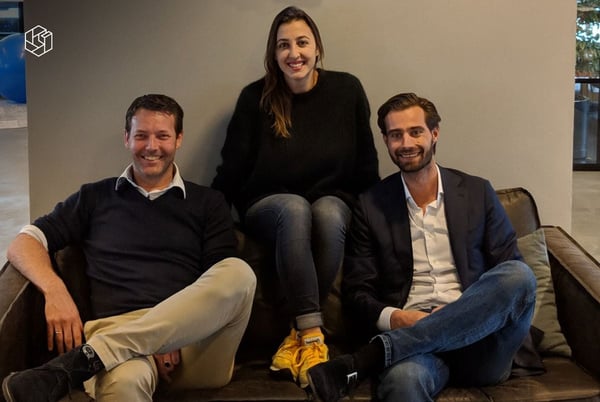
25.04.2018
Omnia Retail Expands Executive Team: Andrea Lamelas Puga Joins as COO
Amsterdam - April 25, 2018. Omnia Retail, leading supplier of pricing and online marketing automation software for retailers, today announced the appointment of Andrea Lamelas Puga (39) as Chief Operating Officer. From...
Amsterdam - April 25, 2018. Omnia Retail, leading supplier of pricing and online marketing automation software for retailers, today announced the appointment of Andrea Lamelas Puga (39) as Chief Operating Officer. From March 15th, she directs Service Delivery & Operations and the company’s finance and HR functions. Lamelas Puga aims to prepare the Omnia team for rapid growth and international expansion. She will professionalize and digitize internal processes, while at the same time ensuring that the company's culture, which makes Omnia unique, is maintained. Before joining Omnia, Andrea acted as Operations Director for Backbase. During her six-year tenure, she has shown remarkable growth, holding positions from Business Analyst to Operations Manager before assuming the position of Operations Director, heading a team of 200. Beyond operations, Andrea developed new services within Backbase as Tribe Director and set up offices in Bogota. “Andrea brings a wealth of operational experience to the table," said Sander Roose and Herman de Jager, founders of Omnia Retail. “We are thrilled to have a steady hand at the helm of operations, as we continue to move forward, growing our team and customer base.” Andrea Lamelas Puga: "At Backbase I had the opportunity to turn challenges into possibilities for growth. With the Omnia team, I am taking on the challenge to embrace growth and creating internal and external opportunities. By improving internal processes, we aim to improve the way we service our customers, both in terms of product and in support." Herman de Jager, Andrea Lamelas Puga, and Sander Roose (from left to right) About Omnia Retail Omnia is the leading B2B SaaS solution for integrated pricing and online marketing automation software. Omnia helps retailers regain control, save time and improve their results. The out-of-the-box solution automates optimal pricing and maximizes returns from Google Shopping. Omnia services more than 80 leading retailers, among which Bol.com, Wehkamp, Blokker, and Decathlon. For her clients, Omnia scans and analyses more than 500 million price points, and makes more than 7 million price adjustments daily.
Omnia Retail Expands Executive Team: Andrea Lamelas Puga Joins as COOSign up to be the first to get information from Omnia.
Sign up now